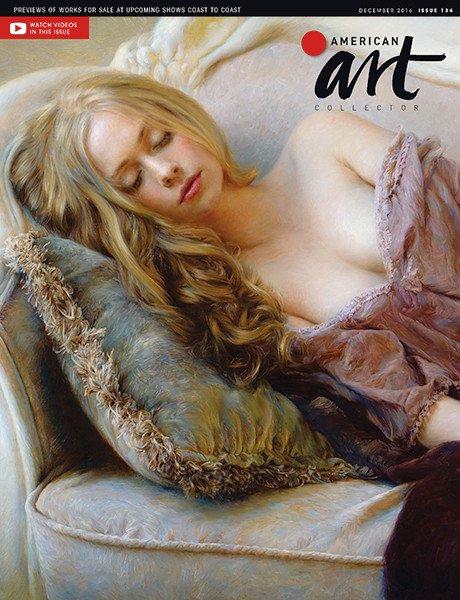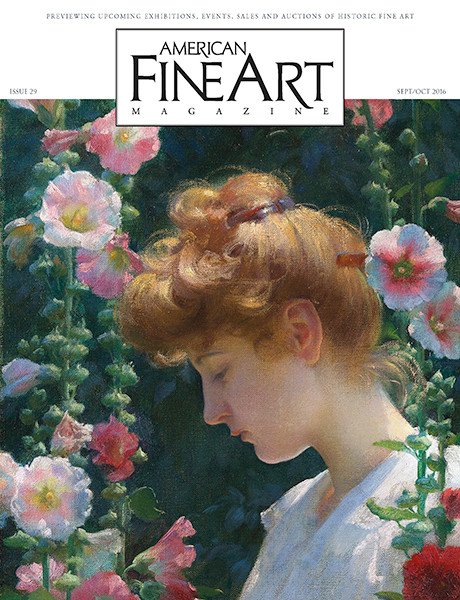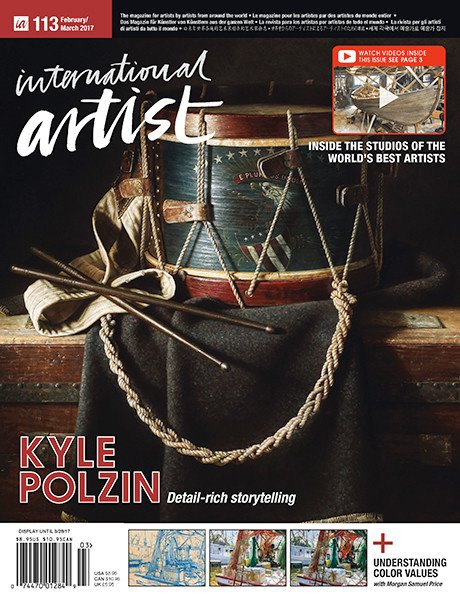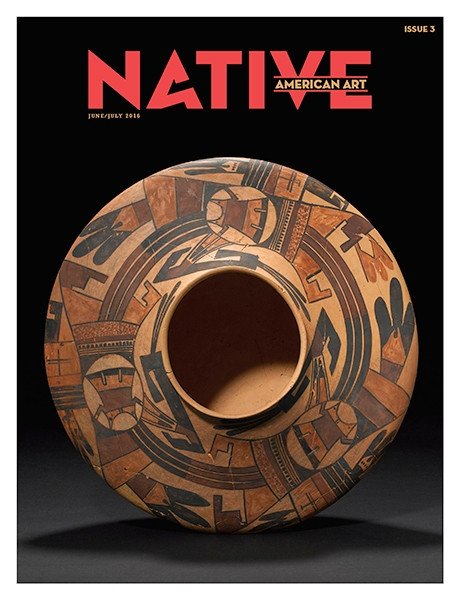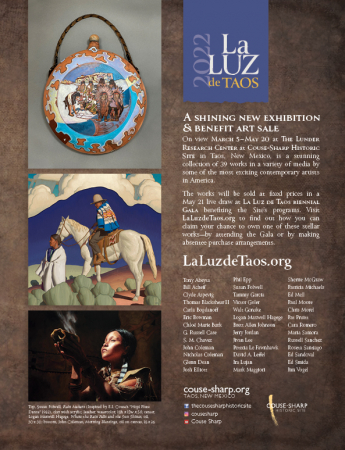The Couse Foundation
The Lunder Research Center, Couse-Sharp Historic Site138 Kit Carson Road
TAOS, NM 87571
5757510369
Email this Gallery
Visit Gallery Website
Couse-Sharp Historic Site, Lunder Research Center
3/8/2022 - 5/19/2022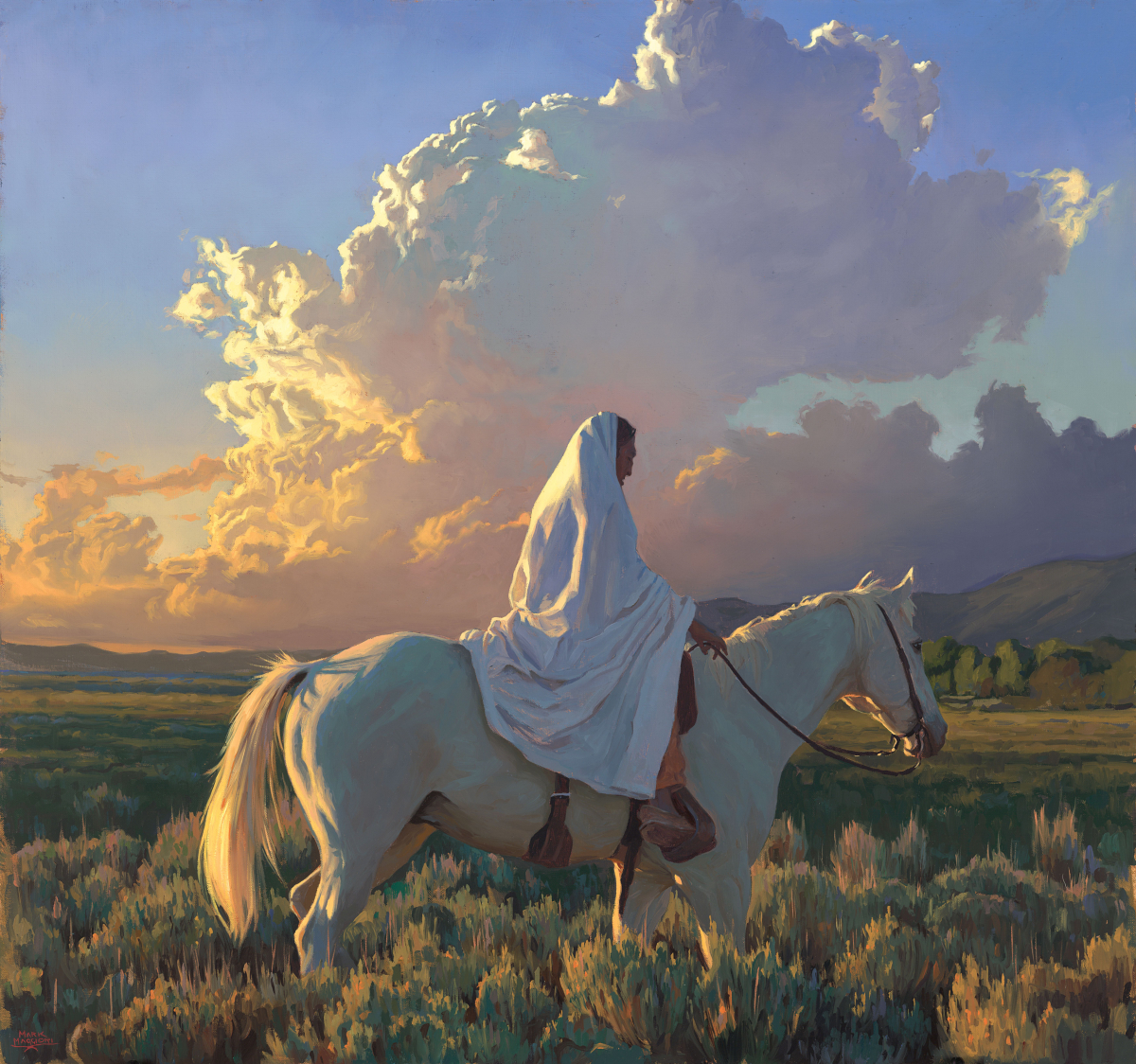
A Sacred Sun
Mark Maggiori
oil
22.5 x 24 inches (L x W)
At the age of 15, Mark Maggiori, who was born in Fontainebleau, France, first glimpsed the American West through the front windshield of a car journeying from New York to San Francisco. Many years later, after an education at the Académie Julian and successful career in the music industry, Maggiori would return to the United States with his wife, Petecia Le Fawnhawk. In 2010, following a visit to the National Cowboy and Western Heritage Museum in Oklahoma City, Maggiori was inspired to dedicate his life to documenting the American West. Known for his visions of modern cowboys and the nostalgic West, Maggiori says, “I love to paint and dream about the good old times. Cowboys always represented, for me, a time when America was still a promise land . . . a huge dream for whoever wanted it.” In addition to his scenes of cowboys and open spaces, Maggiori, who moved to Taos in 2020 with his wife and daughter, has researched and created work inspired by the people of Taos Pueblo and the photographic archives of E. I. Couse.
Maggiori notes that this painting shows Lyle Wright riding at the Mariposa Ranch near Taos.
markmaggiori.com

A Transitional Rio Grande Blanket
Carla Bogdanoff
Navajo-Churro wool
50 x 85 inches (L x W)
With Indigenous and Hispanic heritage, Carla Bogdanoff has a unique background that inspires and facilitates her study of Southwestern textile arts. After moving to New Mexico 15 years ago, Bogdanoff, who grew up in Brazil and California, embraced the weaving art form. Eventually, she became a founding partner in Tres Estrellas Design, a Taos-based gallery specializing in historical textiles of the greater Southwest. Bogdanoff notes that access to rare Indigenous and Hispanic weavings, as well as direct experience employing historical materials and techniques, has aided her study of Rio Grande weaving traditions. In her practice, Bogdanoff weaves highly accurate transcriptions of classical and transitional Rio Grande blankets that strive to capture the subtlety and nuance found in their surviving original examples. She says, “The blankets I weave celebrate traditional Rio Grande striped patterns and locally sourced vegetal dyes.”
Bogdanoff notes that this blanket is a contemporary reproduction of an 1880 transitional Rio Grande weaving and is 100% Navajo-Churro wool hand-dyed with natural and acid dyes.
tresestrellasdesign.com
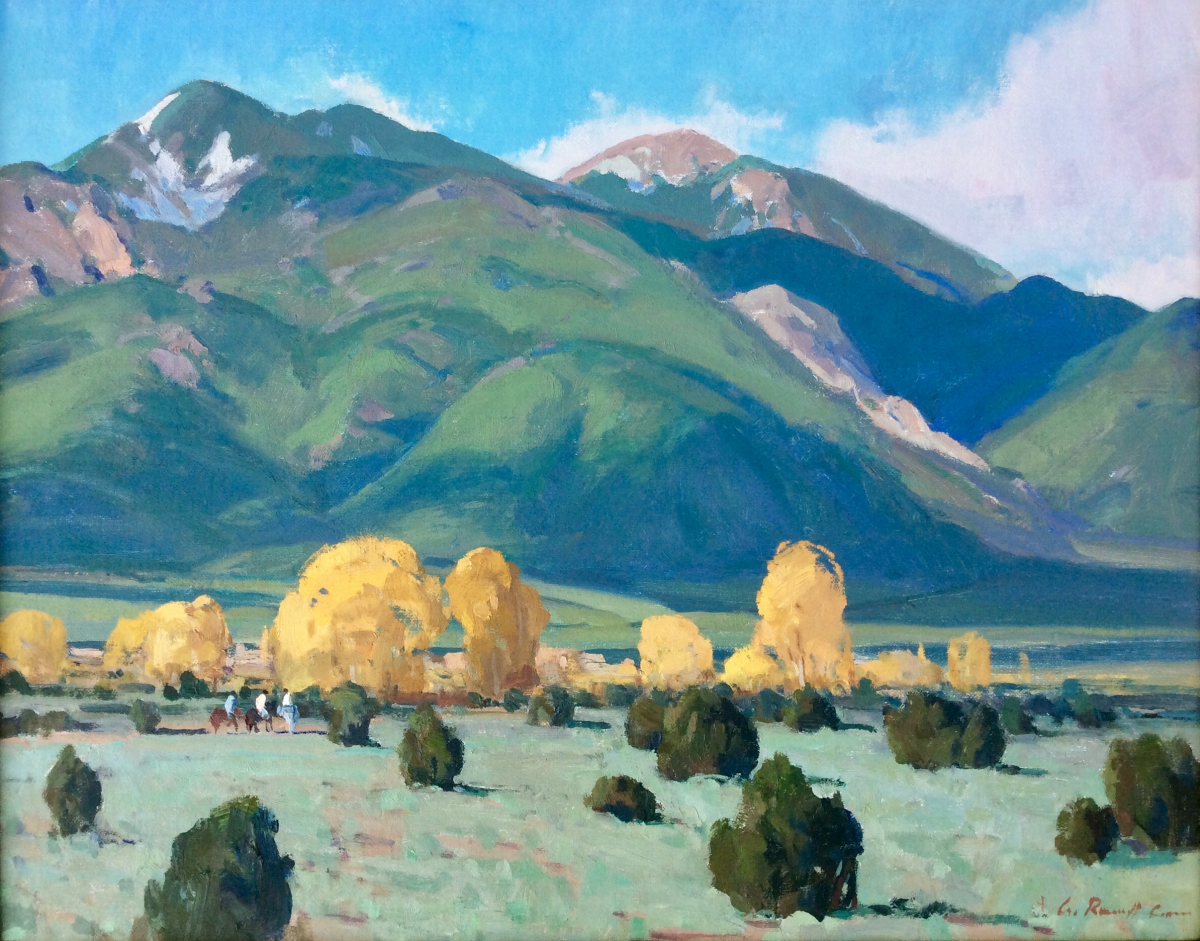
Autumn
G. Russell Case
oil
16 x 20 inches (L x W)
As a child, G. Russell Case’s artistic enthusiasm was fostered by his father, artist Garry Case. Now known as a painter of the American West who creates timeless landscapes, Case paints from nature directly but places little value on creating a literal translation of what he sees. Instead, Case’s keen attention to color allows him to examine and represent nature’s beauty in his own unique voice. In his work, sweeping, idealized versions of Western landscapes combine his rich imagination with the natural world’s beauty. Case notes that he has been inspired by past artists such as Maynard Dixon, whose artwork “totally blew my world apart.” He asserts that those in his life who bolstered his career while remaining faithful to his vision have been his most profound inspiration.
Regarding this artwork, Case says, “Autumn in Northern New Mexico is always an inspiration to me. I never tire of painting it.”
russellcase.com
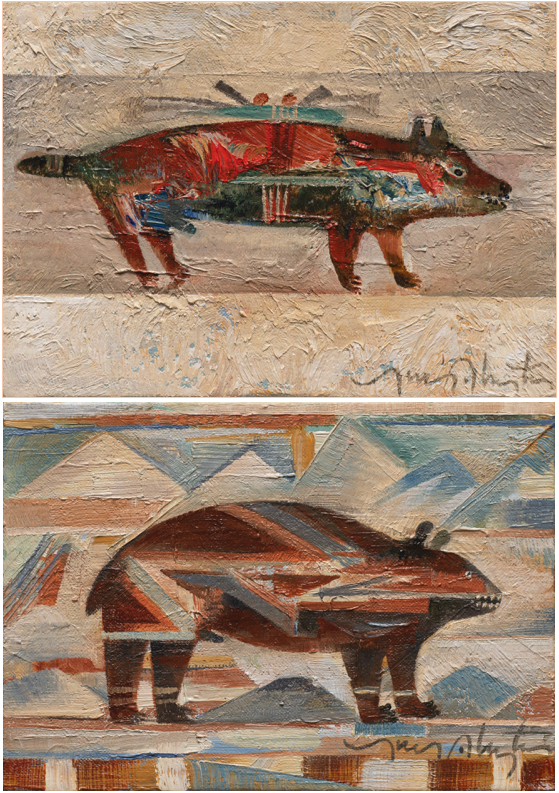
Bear, Badger (Set of Two)
Tony Abeyta
oil on canvas
5 x 7 inches (L x W)
Raised in Gallup, New Mexico, in a community of artists, Tony Abeyta (Diné) is a mixed-media painter who splits his time between Santa Fe and Berkeley, California. Abeyta’s primary focus in his practice is the emotional impact of the landscape, which he explores by using a variety of media such as oil, sand, and charcoal. Evoking the idea that there is power in everything and everyone, Abeyta’s work engages frequently with complex Diné (Navajo) beliefs, and he spends “a lot of time deciphering the light, the cascades of mesas into canyons, the marriage between earth and sky and light” of New Mexico’s scenery. Refusing to work from photographs, Abeyta states that creation process happens on its own, “the way the painting tells me to,” rather than choosing which particular painting to work on at a given moment. The artwork needing attention draws him to itself. Abeyta notes that, regarding the landscape of his home state, “I am beckoned to remember it and then to paint it.”
Courtesy Owings Gallery, Santa Fe
tonyabeyta.com
owingsgallery.com
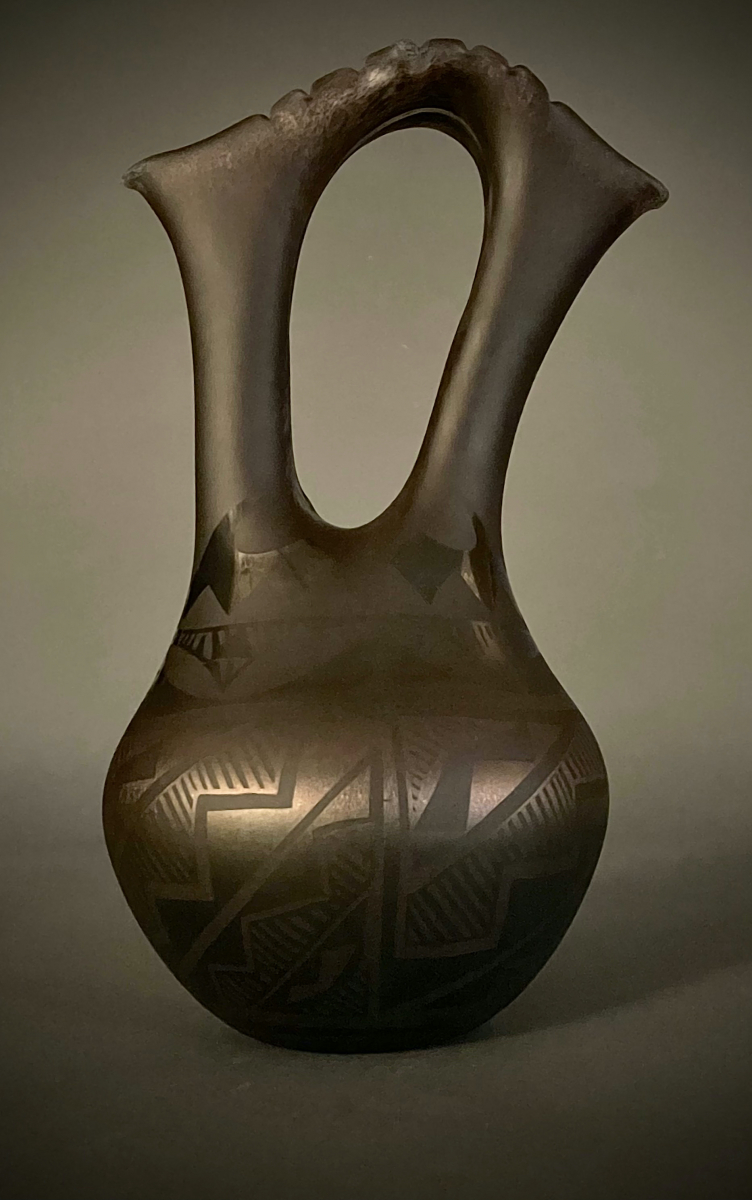
Black on Black Glass Pottery Wedding Vase
Ira Lujan
blown glass
11 x 6 inches (L x W)
Born in Albuquerque but working out of Pojoaque, New Mexico, Ira Lujan (Taos/Ohkay Owingeh Peublo) was first introduced to glass blowing in Taos, where he apprenticed with the glass artist Tony Jojola (Isleta Pueblo). Working with Jojola opened Lujan’s eyes to combining Pueblo themes and subject matter with the ancient art of glass blowing. To create his work, Luhan, who also studied under Preston Singletary (Tlingit) at the Pilchuck Glass School, uses the ancient techniques passed down from Italian glass blowers. Today, Lujan is known for glass chandeliers, Pueblo pottery-inspired vessels, and totem poles, all influenced by and responding to everyday themes in contemporary Native America. He notes that teaching and collaborating with other Native glassblowers has inspired his own practice, and his integration of Pueblo culture into the art of blown glass “reflects a visual language that I have connected to.”
Lujan says, “Through collaborating and teaching glass with other Natives, I have been inspired by the movement. The story it tells is the same as the pueblo culture, and reflects a unique visual language that I have connected to. This interaction has inspired my own work.”
lujan.artspan.com
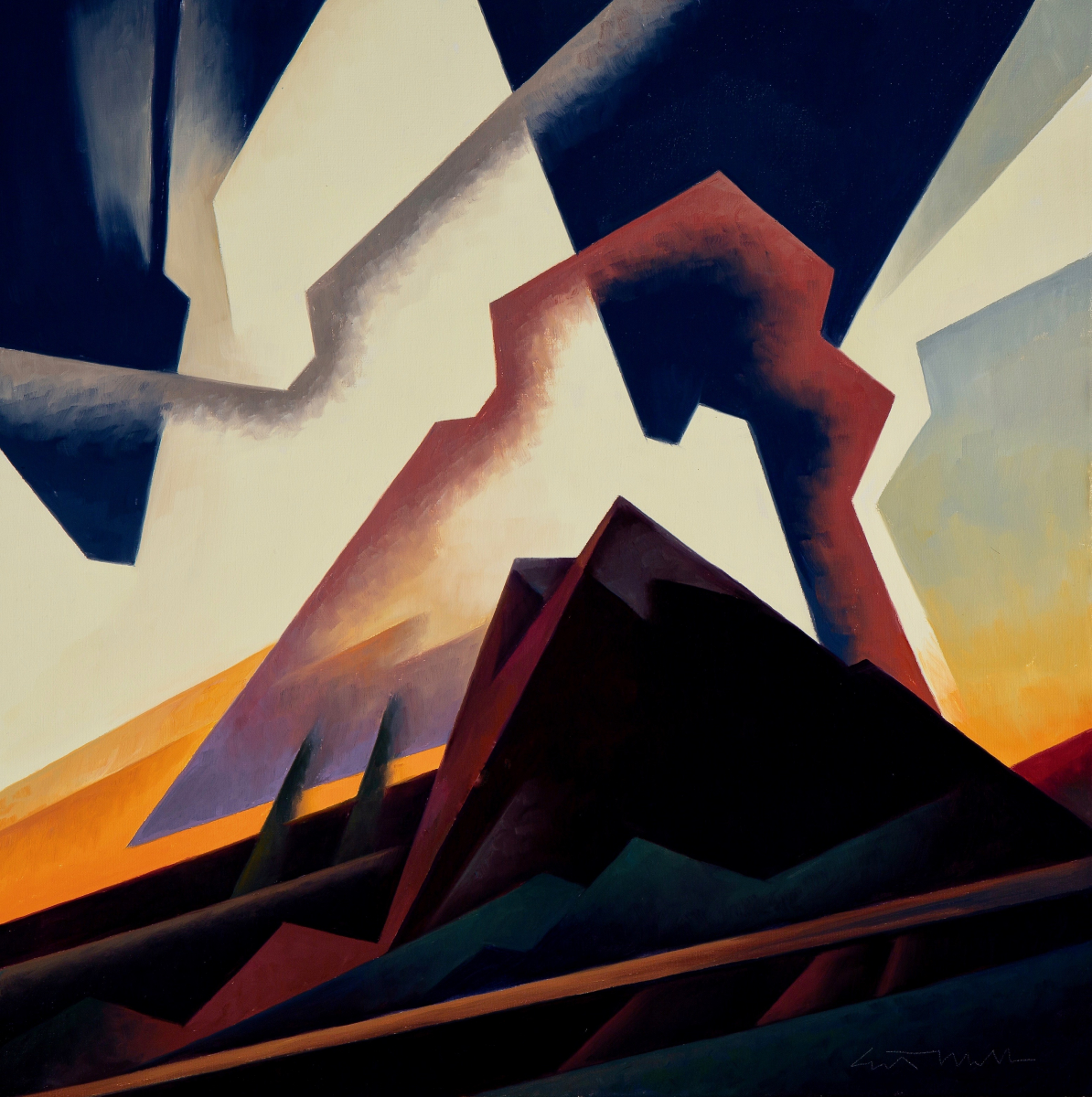
Changing Seasons
Ed Mell
oil on linen
22 x 22 inches (L x W)
As soon as he could hold a pencil, Ed Mell began drawing. Following art school in Los Angeles and an advertising job in New York City, Mell moved back to his native Arizona to teach. The time spent on the Colorado Plateau reaffirmed his love of the land, and he relocated to Phoenix and began painting landscapes. With a range of styles, Mell, who has become well known for his flower paintings, now paints the desert environment with its ever-changing skies. Regardless of subject, Mell is celebrated for his ability to capture the varying light and energy of spacious Western skies. Working from nature, Mell says, “Seeing the real thing has much more impact than a photographic representation of nature, so in order to duplicate nature, I like to push it a little further and bring back some of the impact that nature has in real life.” Mell lives in Paradise Valley, Arizona, and credits influence from a broad gamut of painters, from European Modernists, to American Modernists, to the Taos Founders and Maynard Dixon.
edmellgallery.com
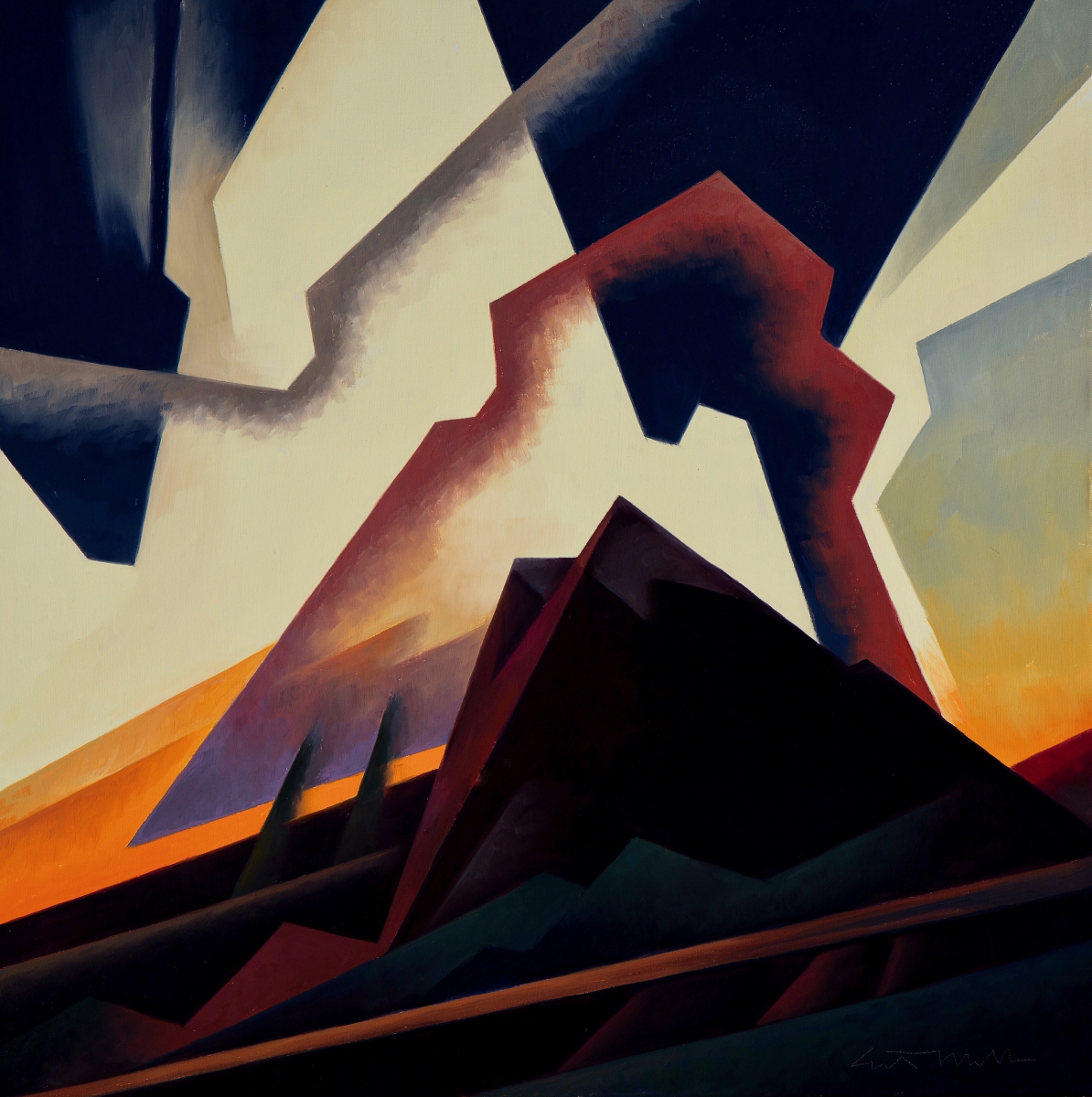
Changing Seasons
Ed Mell
oil on linen
22 x 22 inches (L x W)
As soon as he could hold a pencil, Ed Mell began drawing. Following art school in Los Angeles and an advertising job in New York City, Mell moved back to his native Arizona to teach. The time spent on the Colorado Plateau reaffirmed his love of the land, and he relocated to Phoenix and began painting landscapes. With a range of styles, Mell, who has become well known for his flower paintings, now paints the desert environment with its ever-changing skies. Regardless of subject, Mell is celebrated for his ability to capture the varying light and energy of spacious Western skies. Working from nature, Mell says, “Seeing the real thing has much more impact than a photographic representation of nature, so in order to duplicate nature, I like to push it a little further and bring back some of the impact that nature has in real life.” Mell lives in Paradise Valley, Arizona, and credits influence from a broad gamut of painters, from European Modernists, to American Modernists, to the Taos Founders and Maynard Dixon.
edmellgallery.com

Couse Geranium
Clyde Aspevig
oil on linen
30 x 36 inches (L x W)
Residing currently in Montana, Clyde Aspevig developed a lasting, positive relationship with the land as a young boy. In his painting practice, Aspevig’s “wellspring” is the land itself, with all its forests, coulees, shores, and peaks. Believing that “an ever-evolving intimacy with this chosen subject matter was the most effective education,” he returns to his chosen landscapes repeatedly to examine its changes throughout the seasons. While Aspevig’s paintings of the land might appear “real,” he emphasizes that they are “abstractions in the truest sense” realized through experiments in his studio with pure form and accidental color. Aspevig believes that his gift for finding “unexpected beauty in nature” is due to his musical and inquisitive parents, and his goal is that viewers of his work leave with the sensation of having visited that landscape themselves.
The view captured in Couse Geranium is on the portal (porch) of the Couse Home at the Couse-Sharp Historic Site in Taos. Aspevig says, “The geranium was the perfect accent to this elegant and charming home so full of history and creativity.”
clydeaspevig.com
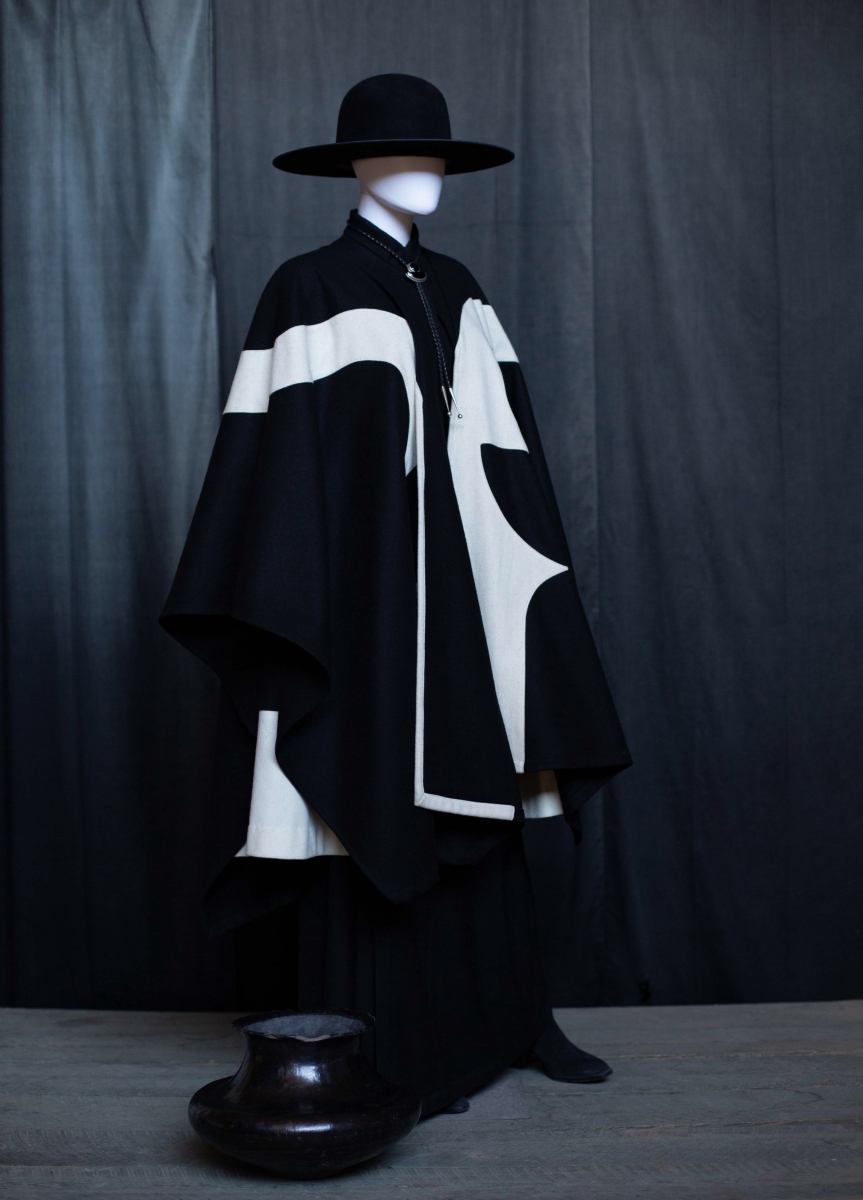
Desert Totem Poncho
Petecia Le Fawnhawk
ensemble, includes skirt, bolo, hat
Raised in the high desert of Arizona, Petecia Le Fawnhawk is a multimedia artist known for ethereal artwork that draws from and combines elements of Surrealism, Minimalism, and Modernism. While Le Fawnhawk is comfortable working in video, fashion design, photography, and sculpture, her aesthetic output is “an ongoing experiment with eliminations, reductions, abstraction, and refinements in a world of mystery and Surrealism,” regardless of media. With her partner, Mark Maggiori, Le Fawnhawk enjoys traveling throughout the deserts of the Southwest and California, which she describes as “my happy place.” Now based in Taos, Le Fawnhawk started a high-end fashion collection during the beginning of the COVID-19 pandemic. With this collection, she hopes to express a “deeply unique graphic surreal minimalist world.”
lefawnhawk.com
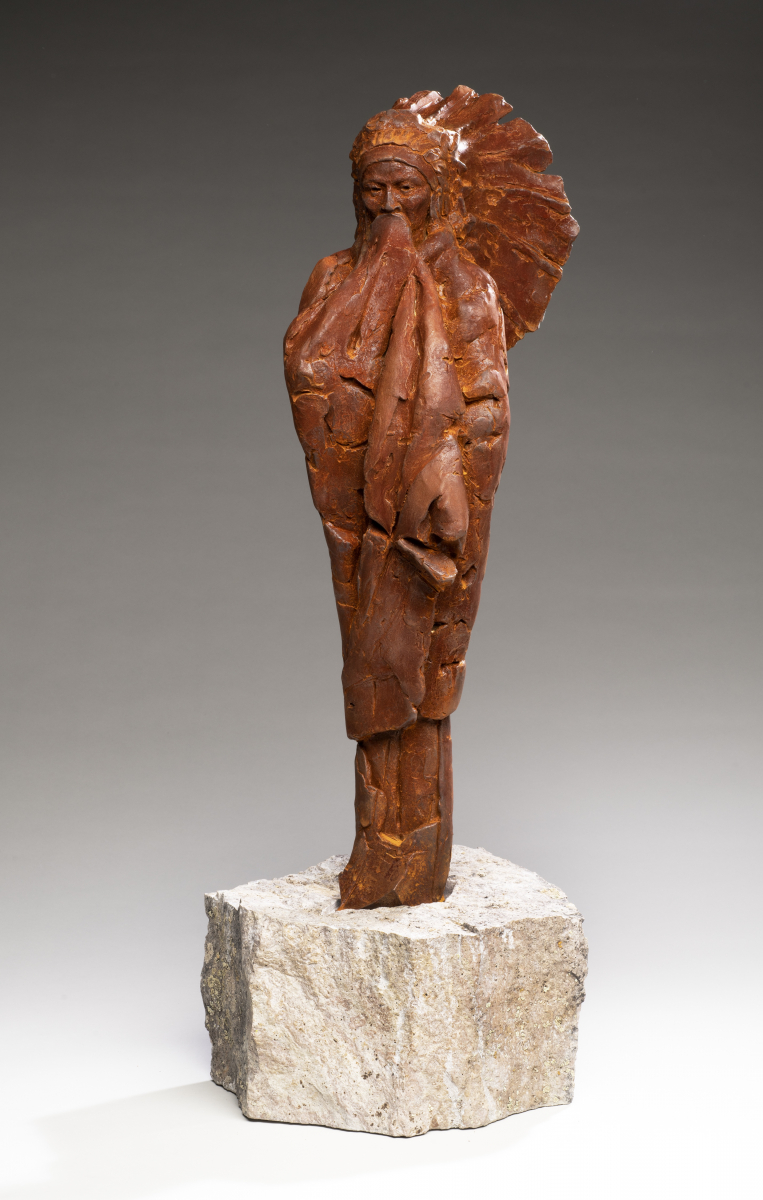
Elemental
Ed Smida
iron
29 x 12 x 10 inches (L x W x D)
Residing currently in Santa Fe, Ed Smida began his artistic career after a 30-year stint working in science, operations, and finance. The visual arts were always a major part of Smida’s life. As a child, a family trip through the West in a Winnebago opened his eyes to the wonders of the region’s national parks, and he has spent the past 40 years calling the West home. His sculptures focus primarily on rendering the human form, and he executes most of them using the lost wax method of bronze casting. Smida is inspired continually by the history, cultures, people, traditions, and spiritualties of the West generally and New Mexico in particular. “I especially love living and working in New Mexico,” Smida says, and notes that the state’s “expansive backdrop, combined with the simplicity of the architecture, affords me a perfect foundation for my work.” Smida lists masters such as Rodin, Giacometti, de Staebler, and Carlson as influences and inspirations for his own artistic practice.
Smida says, “Elemental considers the very deep, powerful, and essential connection between man and nature. My goal was to explore the limits of non-traditional materials (cast iron with natural patina, rock base in original found state) to heighten the feeling of strength, mystery and introspection.”
edsmida.com
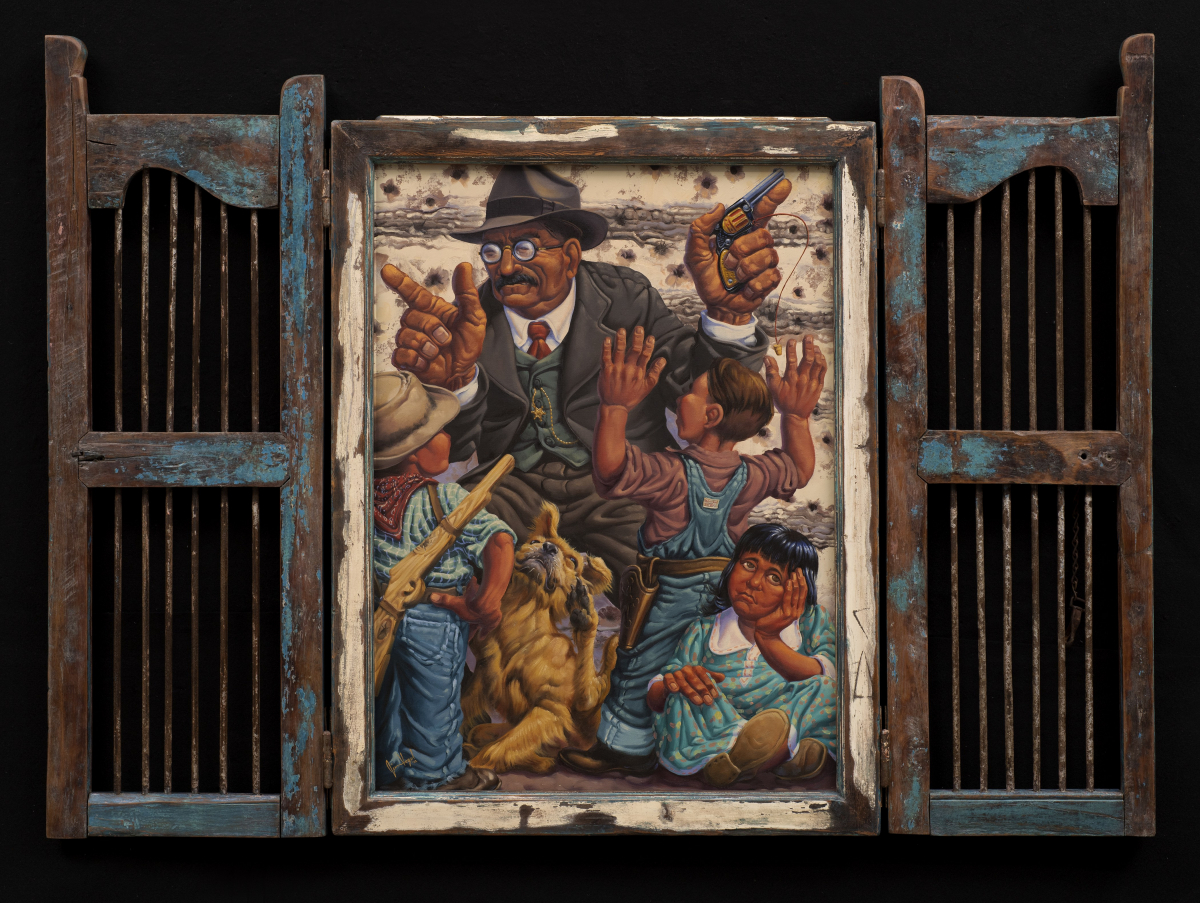
Elfego Baca Recounts his Standoff
Jim Vogel
oil on canvas panel
34 x 25 inches (L x W)
Growing up as the self-professed “weird art kid” in Roswell, New Mexico, Jim Vogel comes from a family of storytellers, a background that now pervades his own artwork. At home in the heart of New Mexico, Vogel paints scenes of New Mexican myth and folklore in an attempt to “put images to these stories I’ve heard over and over from my mother and father.” Reminiscent of Thomas Hart Benton’s social realist and regionalist works, Vogel’s narrative paintings feature frequently New Mexico’s working-class and rural poor in an attempt to relate the common man’s struggle. In addition to his paintings, Vogel creates elaborate, handmade frames to enhance his scenes. Based in Dixon, New Mexico, Vogel participated recently in “Taos Six Collection: An Homage to Joseph Henry Sharp” at the Blue Rain Gallery, in which he showed his work Matching the Color of Sangre de Christo, after Joseph Henry Sharp’s The Old Santos Mender. Framing of Elfego Baca in collaboration with Christen Vogel.
Vogel says, “I was inspired by the story of self-deputized Elfego Baca (1865–1945) of Socorro, NM, and his standoff with forty Tejano cowboys. In October of 1884, Baca arrested a cowboy for drunkenly shooting up the small town of San Francisco Plaza. After a quick frontier-style trial the cowboy was released with a small fine.
“Word of the arrest got back to the cowboy’s coworkers who then set out to avenge his treatment. This lead to a three-day standoff with Baca inside a small jacal building (post and adobe construction) and forty, possibly up to eighty, Tejano cowboys shooting at him from the plaza area. After 4,000 rounds fired and four dead cowboys outside, Baca agreed to surrender to an actual deputy with a guarantee of safe passage to Socorro. Elfego Baca was charged with the murder of the dead cowboys. At his trial Baca presented the bullet-riddled door to the jacal, pointing out that he was on the other side. He was acquitted.
“This came to be known as the Frisco Shootout. It was the springboard that lead to his burnished reputation and a career as the actual sheriff of Socorro County (elected this time), criminal lawyer, US marshal, bouncer in a Juarez casino, local politico, and classic Nuevo Mexicano legend.”
blueraingallery.com/artists/jim-vogel
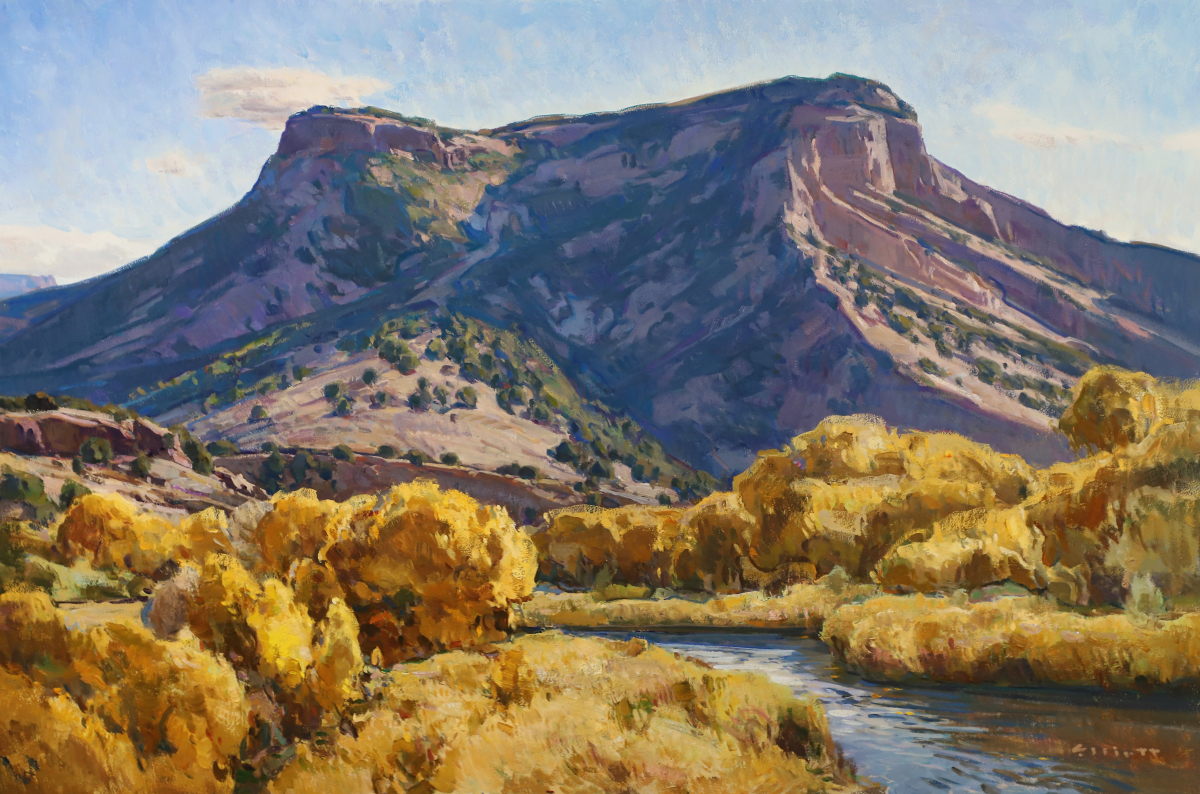
Full Swing on the Rio Grande
Josh Elliott
oil
20 x 30 inches (L x W)
As a child, Josh Elliott, who is a third generation artist, was raised with an appreciation for art. In addition to his grandfather, a classmate of Grant Wood’s, Elliot’s father, Steve, has been the most important influence on his career. Elliot learned about not only value, composition, and color from Steve, a wildlife artist, but also the importance of painting outdoors. With a deep respect and awe for Mother Nature, Elliot views his outdoor paintings as reactions to what is in front of him and attempts to “capture the transient light and the overall beauty of [a] place.” To Elliot, who lives currently in Helena, Montana, the terrain of the Southwest provides an interesting intermingling of ancient and modern subject matter. He says, “You can’t help but feel the sense of time in the desert,” and he enjoys portraying the theme of “man against the elements.” Regardless of location or evidence of man’s interference in nature, Elliot tries to “tell the story of the place” in his work.
Of this artwork, Elliott says, “I love seeing landmarks that the great artists in history have painted; it helps me feel a connection with them. I feel like I am seeing the beauty they saw and the passage of time slips away as I look upon the unchanged geography. This bluff is featured in one of my favorite paintings by Ernest Blumenschein. I have included the clouds hanging on the top of the formation as an homage to one of my heroes.”
joshelliottart.com
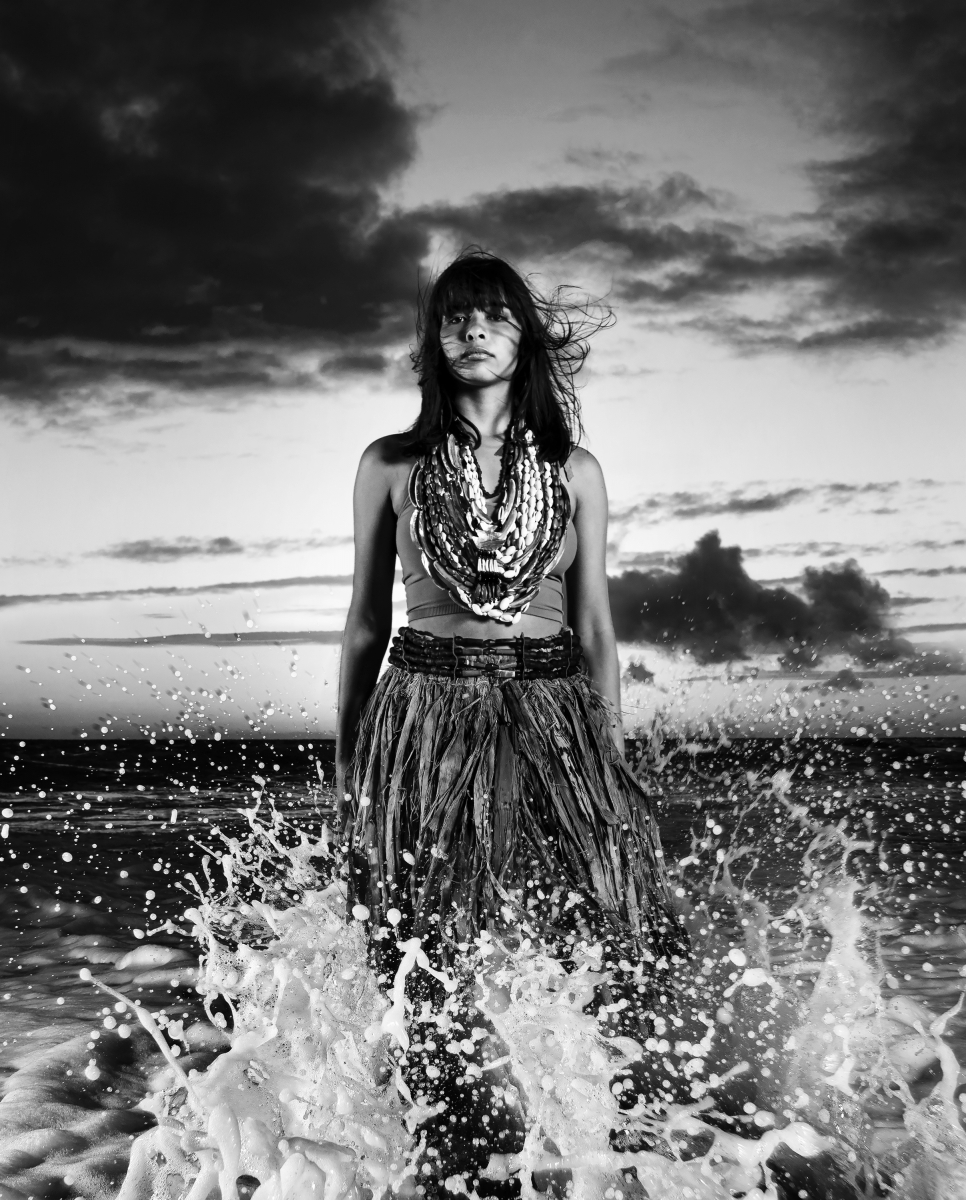
Hermosa
Cara Romero
archival photographic print, edition 7 signed and numbered,
51 x 40 inches (L x W)
Fusing culturally specific symbols with 21st-century ideas, the work of Cara Romero (Chemehuevi Indian Tribe) resists Eurocentric narratives to emphasize the diversity of contemporary Native American individuals. Raised both in urban Houston, Texas, and the rural Chemehuevi reservation in California’s Mojave Desert, Romero strives to “create a critical visibility for modern Natives, to get away from that one-story narrative, and to dig into our multiple identities.” Her photographs are often theatrical in composition and color and feature tribally diverse models. To further take the role of storyteller and counter photography’s exploitative past, Romero collaborates with her models to stage scenes they feel give back to Native communities and are important. Romero asserts that her work “offers viewers sometimes serious and sometimes playful social commentary on pressing issues like the border wall, the hypersexualization of Native women in the histories of photography, environmental destruction of Native lands, and stereotypes of Indigeneity in pop culture.”
This edition of Hermosa, prints of which are in the collections of The Huntington and the Minneapolis Institute of Art, is printed by the artist on Legacy Platine paper. Romero notes, “This spectacular image was captured candidly during an intimate shoot at sunset with my daughter, Crickett Tiger, on the shore of Hermosa Beach. Going to Los Angeles was a homecoming to my birthplace, but it was also a pilgrimage to the Chemehuevi place of creation. These months we spent at the beach became a modern remembrance of Chemehuevi creation stories and creation songs and the mythos of Great Ocean Woman (Hutsipamamow). They became a visualization of the indigenous worldview that these places, however developed, are still holy places to First Peoples.”
cararomerophotography.com
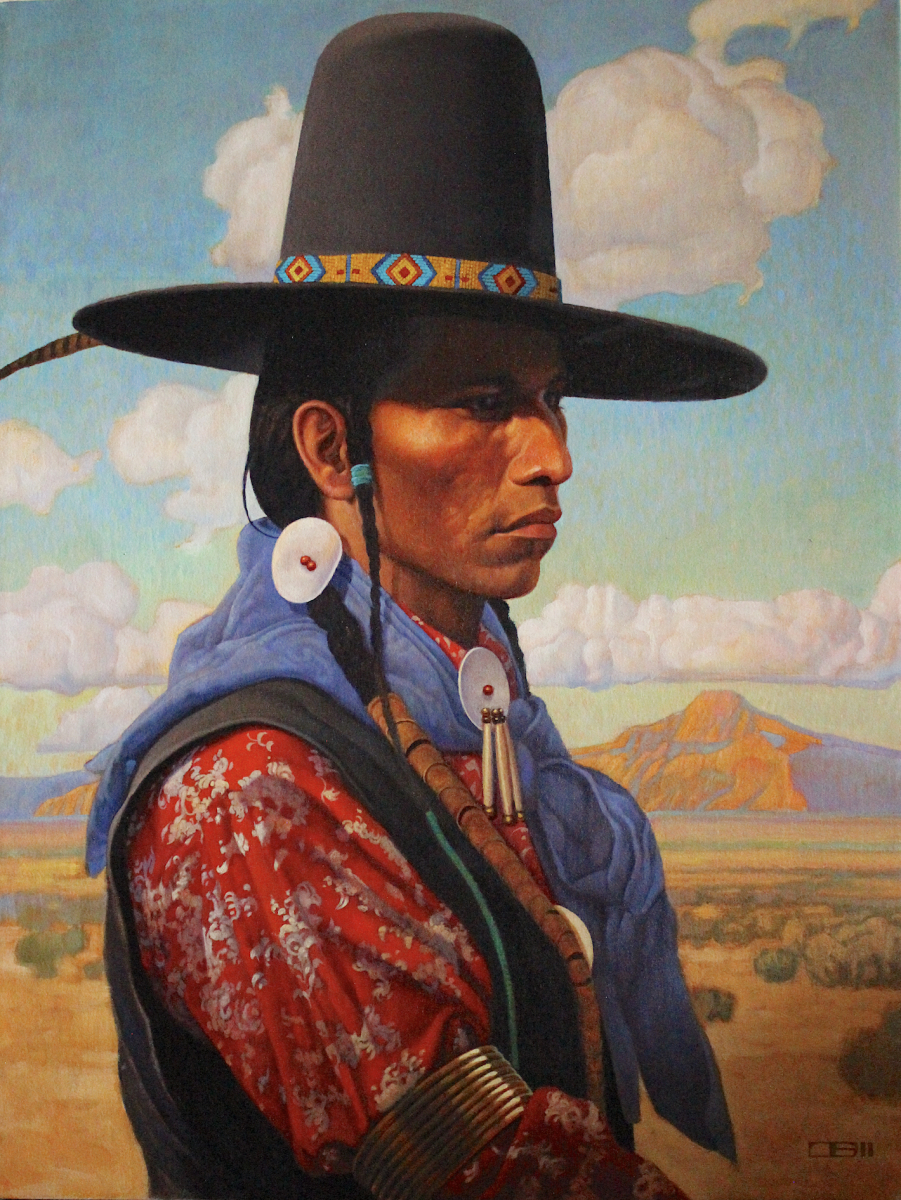
High Hat
Thomas Blackshear II
oil
31 x 23 inches (L x W)
As a child, Thomas Blackshear II filled pages of sketchbooks with “things of wonderment,” objects and characters that have and continue to inspire his artistic practice. After a highly successful career in illustration, one in which he worked for clients such Disney and George Lucas Studios, Blackshear is challenging and revitalizing the Western art genre with his paintings. Recognized for his attention to mood and dramatic lighting, Blackshear blends Art Nouveau and Art of the American West influences in his work to create the hybrid genre of “Western Nouveau.” He states that, to inform his practice, he studies “golden age illustrators” and European artists such as Gustave Klimt and Alphonse Mucha. In his compositions, Blackshear examines frequently some of the neglected stories of American frontier life, including Black cowboys and the Black experience of the West. The result is a “fresh kind of Americana” that provides both complement and contrast to many well-known images of the American West.
Blackshear says he chose this painting as a good fit for a show in Taos.
thomasblackshearii.com
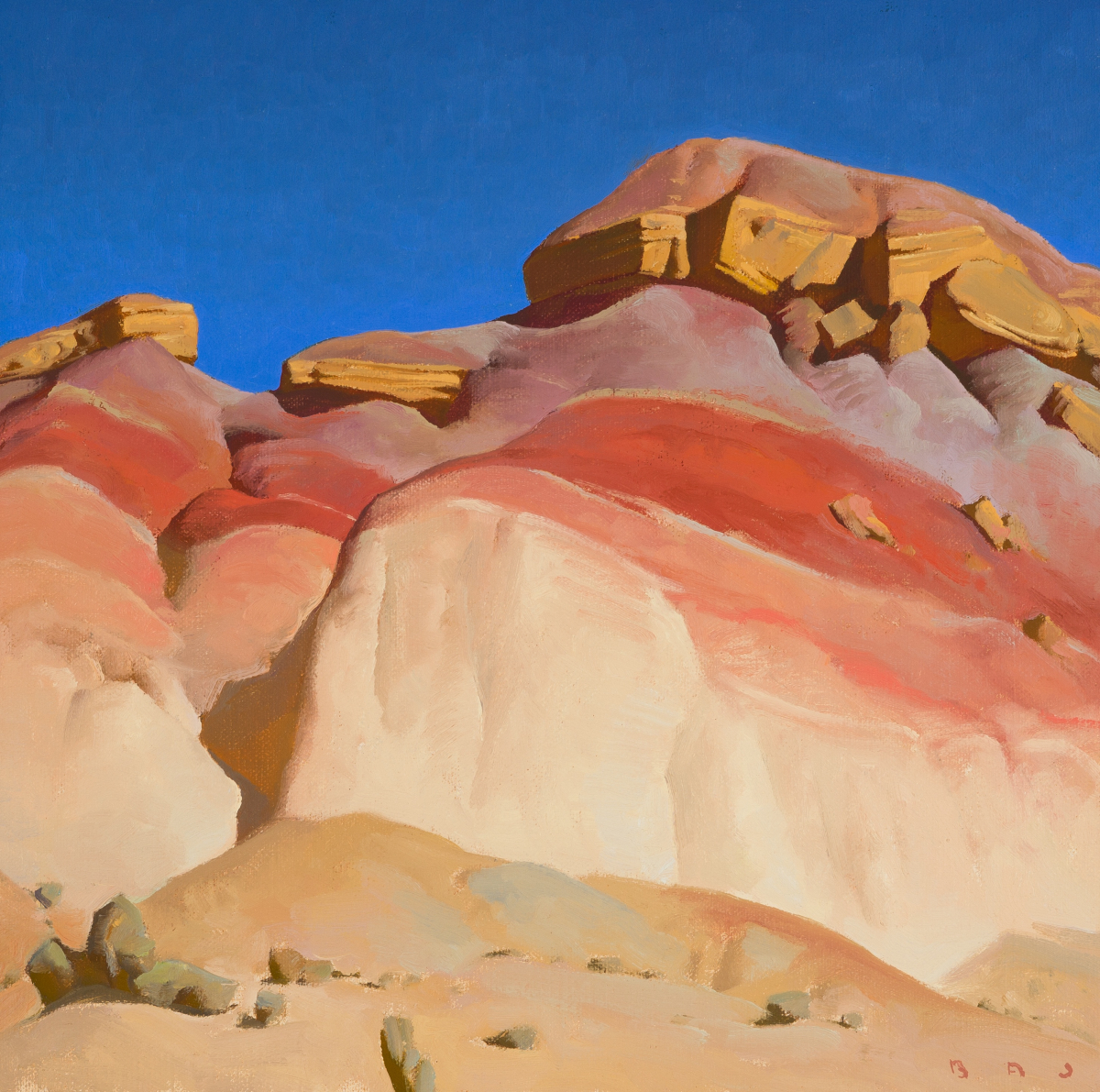
Hills of Clay
Brett Allen Johnson
oil
10 x 10 inches (L x W)
Childhood trips to Arizona to visit his grandmother, a landscape watercolorist, proved to be a milestone in the career of Brett Allen Johnson, who would grow up to paint the Southwestern landscape himself. Based currently in Lehi, Utah, Johnson worked as a carpenter for 16 years after college. This career path has proven beneficial in his artistic practice, helping him visualize and execute an idea. The work of the Taos Society of Artists and Maynard Dixon showed Johnson that the West “could be as modern as he wanted.” He has enjoyed blending contemporary and traditional aesthetics in his images of the Southwest ever since. While Johnson makes regular pilgrimages throughout the West, his paintings do not represent specific places. Instead, “I like to invite observers into a world which is merely similar to the one they know, an adjacent world. Perhaps, the adjacent West.” Johnson has spent most of his life living in and visiting various states in the West, including New Mexico. “I’ve developed a real love for Taos,” he says. “I just adore it all.”
Johnson says this painting is based on the clay hills near Caineville, Utah.
bajfineart.com

Hummingbird
Tammy Garcia
#AC35, bronze
5.5 x 10.5 x 2 inches (L x W x D)
Surrounded by potters in her early life, Tammy Garcia (Santa Clara Pueblo) first learned to make pottery from her mother and began her ceramics career at age 16. The process of making pottery was woven into her childhood chores, but Garcia notes that, “I think it was an incredible opportunity to be born into a family of potters that goes thousands of years back,” and she has taught her own daughters how to make pottery. The work that Garcia creates references both traditional Pueblo motifs as well as modern aesthetic movements, including Art Deco, to form a type of “Neo-Pueblo” design vernacular. Garcia explains, “Early on I realized that, to hold my interest, I needed to keep finding new imagery and to continually do something different.” Today, Garcia works in both ceramics and bronze.
Regarding this artwork, Garcia says, “As a teenager I learned to make pottery from my mother, Linda Cain. She was born in Santa Clara Pueblo, NM, USA. It was there she taught me how to make coil built pottery in the pueblo style. It is the historical pottery of the Southwest that continues to inspire me. On this bronze wall hanging sculpture, Hummingbird is surrounded by floral and abstract designs.”
kinggalleries.com/brand/garcia-tammy

In the Warm Sun
Glenn Dean
oil
16 x 20 inches (L x W)
Largely self-taught, Glenn Dean was aware of his interest in creating art by age 13, but it took several years for him to realize his passion for landscape painting. At the age of 20, Dean completed his first outdoor painting in Arizona, and he has been dedicated to the art form ever since. Early in his career, the work of Western landscape painters of the early twentieth century, including Maynard Dixon and Edgar Payne, directed the path of his own practice. From these influential artists, Dean learned to observe carefully “the simple and basic characteristics of a specific location” while recognizing the “importance of seeing the color of light.” Painting on location throughout the Southwest, including four years spent in New Mexico, Dean is intrigued by the relationship between a figure and their surroundings. With a bold, graphic look to his compositions, Dean’s artwork aims to honor “the things in the world that [he] finds to be beautiful.”
Dean notes that this painting depicts a scene at Taos Pueblo.
landscapesofthewest.com
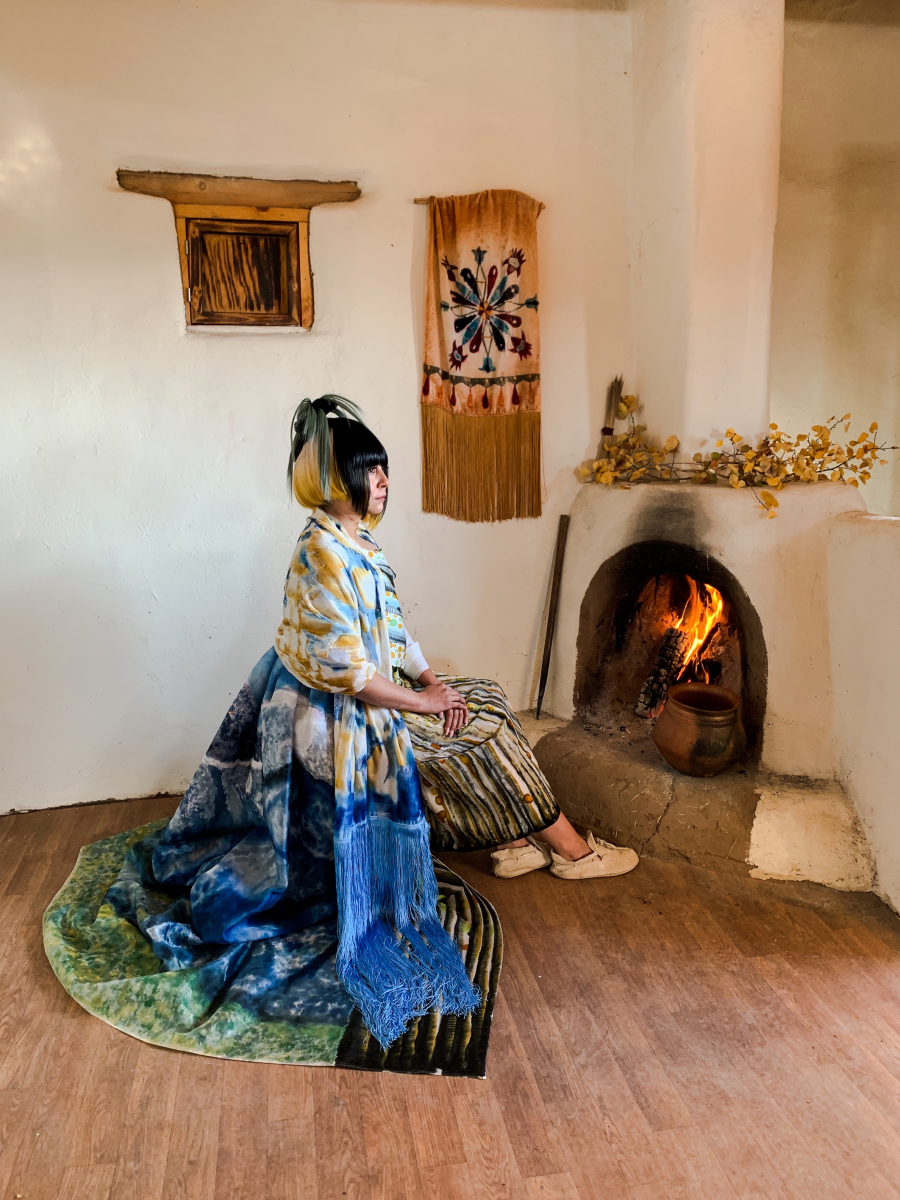
Inside the Taos Pueblo Mountain
Patricia Michaels
mixed media (cloth, painting, devoré, distressing, beading), women’s size 8
From a young age, Patricia Michaels (Taos Pueblo) knew she wanted to be a designer, and by the second grade she created her first garment. Growing up in Santa Fe, Michaels would admire the designs and models in fashion magazines, but her grandfather taught her that the most beautiful part of life is found in nature. As a child, she spent considerable time at Taos Pueblo, where many of her family members lived. Vowing to keep her Native traditions alive through her fashions, for over 20 years Michaels has been producing unique haute couture that draws inspiration from nature and her Native roots. The name of Michael’s company, PM Waterlily, includes her Native name, and recurring themes in her work include cloud patterns, eagle feathers, and rain. In 2012, Michaels was on the television show Project Runway, in which she was first runner-up and the first Native designer to appear on the program. She returned for a season of Project Runway All Stars. Michaels has definite inspirations for her garments and says, “My clothes tell a story, where the wearer gets to incorporate their own history and energy into the garment.”
Of Inside the Taos Pueblo Mountain, Michaels says she drew inspiration from the Taos Society of Artists and being a traditional woman from Taos Pueblo. “I took time periods of the past bringing our continued traditions into the present day, who we are as Native Taos women today.”
Photos by Deborah Lujan
patricia-michaels.com
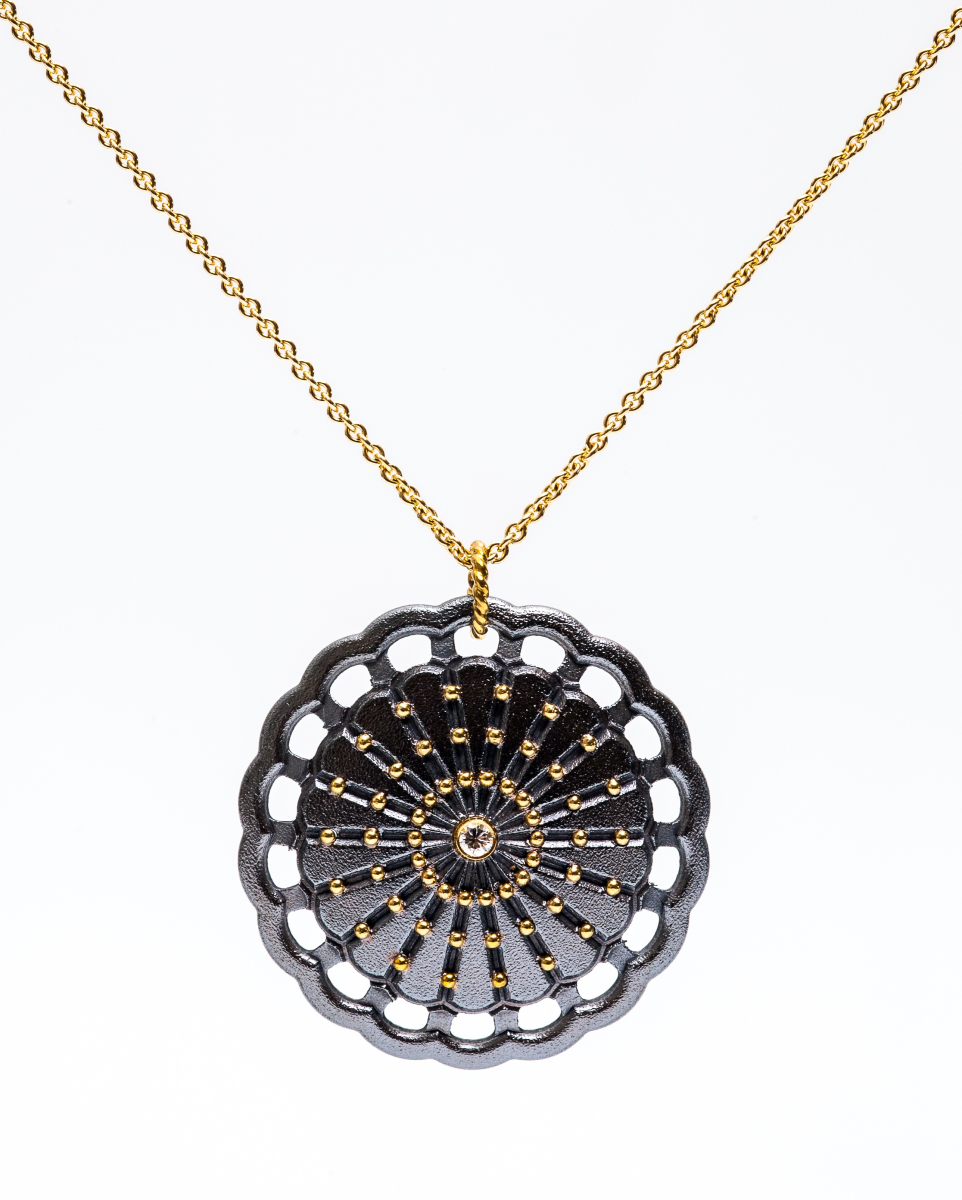
Lace Necklace, Lace Bracelet, and Lace Earrings
Maria Samora
oxidized sterling silver with 18K gold dots
Creating jewelry that combines Pueblo influences with Taos’s “simple and grounded lifestyle,” Maria Samora (Taos Pueblo) makes wearable art with her husband, Kevin Rebholtz, at Samora Studio. After college, when she embarked on an intensive course with a master goldsmith, Samora realized that jewelry was her passion. Now known for clean designs, Samora states, “The purpose of my art is to accentuate the body and capture the movement of the human form.” Her work is inspired not only by Pueblo tradition but also from the hands-on manipulation of patinas, stones, textures, and metals. Drawing from nature, Samora designs can be described as “natural forms made contemporary.”
Samora notes that these three pieces are part of her Lace Collection, and that the pendant is 1.5 inches in diameter and is on an 18” chain.
mariasamora.com
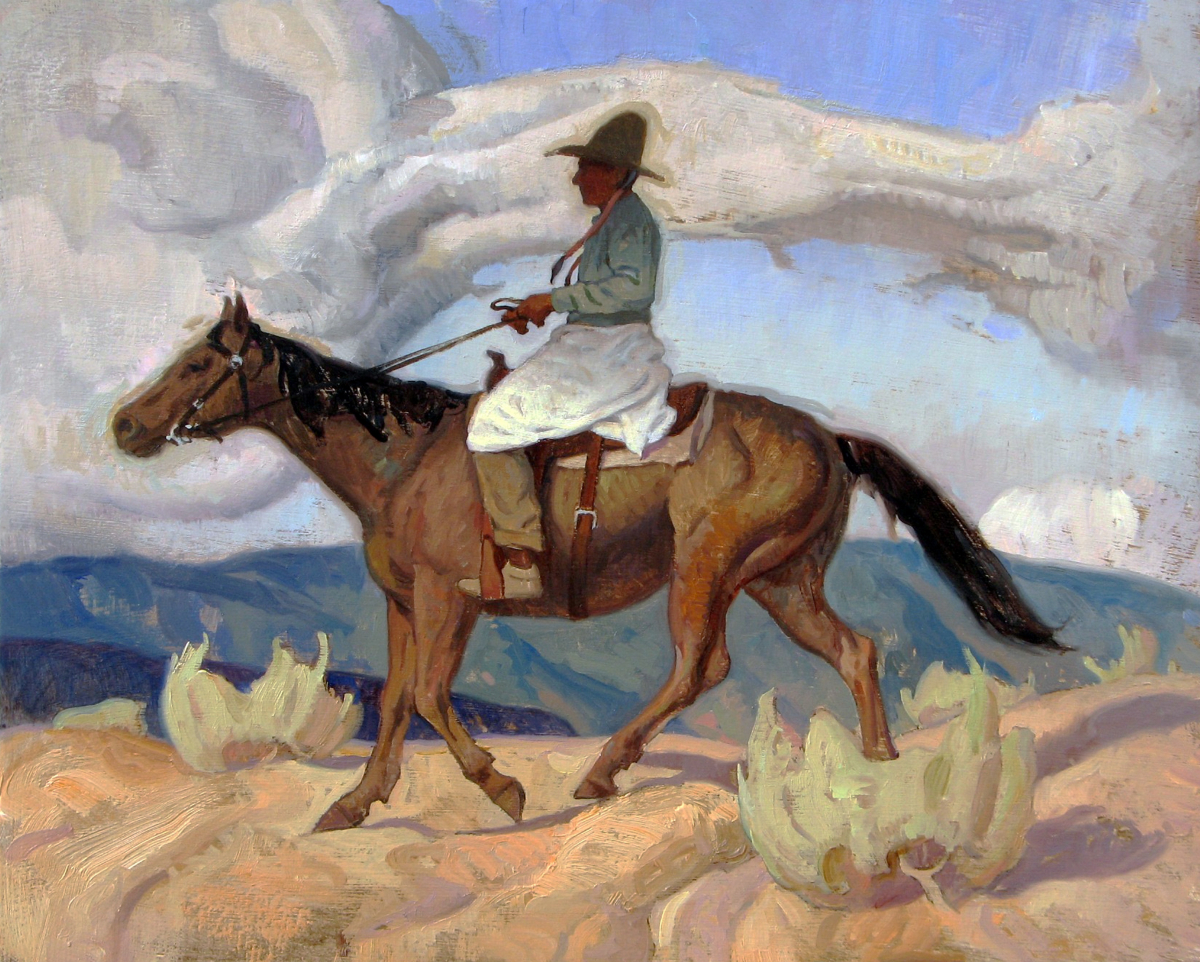
Little Big Man
Eric Bowman
oil
8 x 10 inches (L x W)
For as long as he can remember, Oregon-based Eric Bowman has had an affinity for drawing. Through exploration and self-education, he has developed a unique style of painting that draws from Russian Impressionist and American Impressionist predecessors. In his compositions, Bowman emphasizes light and shadow with oil paint, which he calls “a very organic and sensual medium that engages my senses.” While he loves “the cowboy as a heroic American image” and tackles Western subjects in his work, Bowman asserts, “You’ll never find me wearing a big belt buckle and a hat and boots . . . I’m not a cowboy.” Yet he is clear that he has loved the West since childhood, loves the outdoors, and loves painting. His current work is a reflection and combination of those loves.
Bowman notes that Little Big Man is inspired by the people of Taos Pueblo.
ericbowman.com
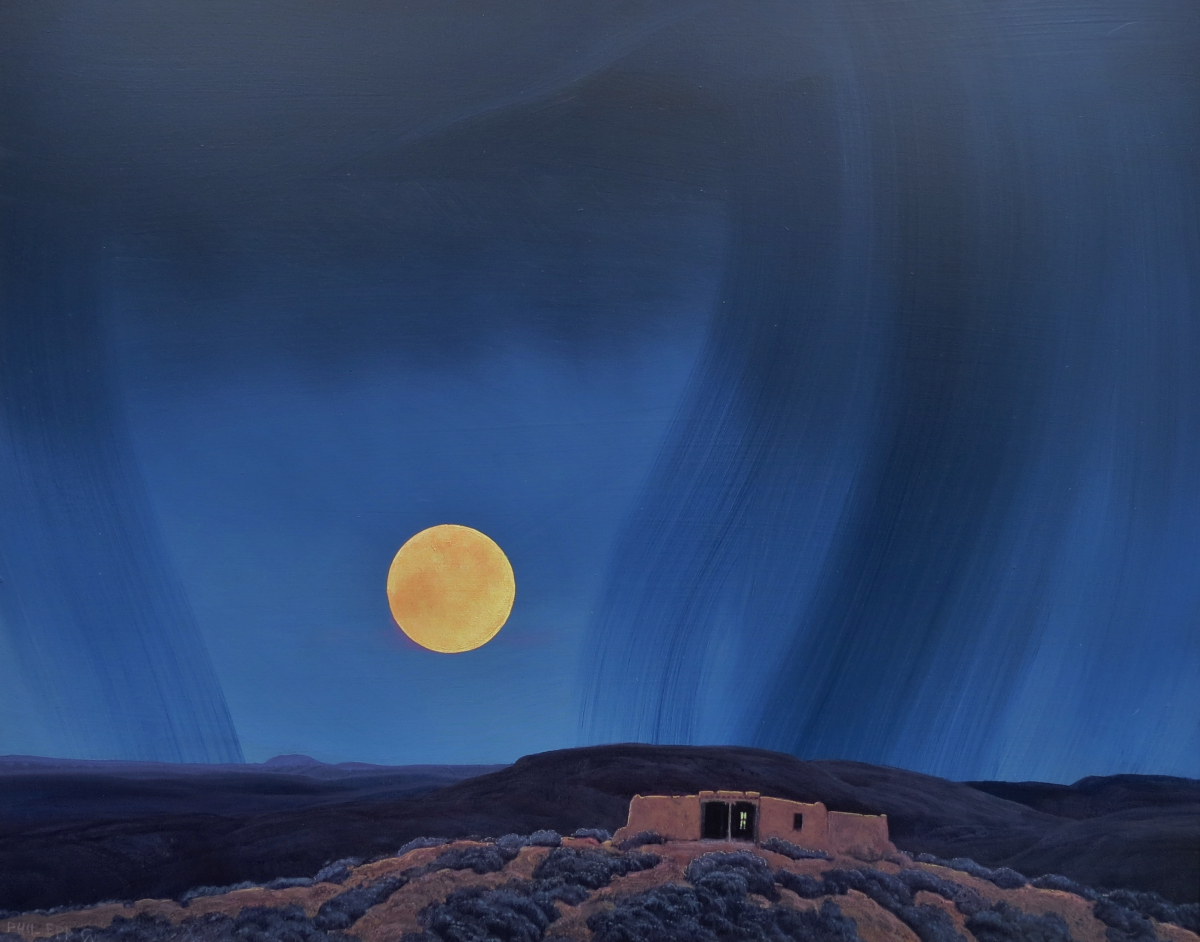
Moon and Adobe no. 5
Phil Epp
acrylic on board
24 x 30 inches (L x W)
Raised on a ranch with his days spent riding horses, playing in the pastures, and taking care of cattle, Phil Epp states that he is “strongly imprinted into the open spaces of the Great Plains where I was born and have spent most of my life.” As a young child, Epp knew that art was something that came to him naturally, and he has been painting for more than 40 years. The emptiness of the American West is of great interest to Epp, whose unique paintings depict windswept prairies, vast deserts, and billowing cloud formations. As he describes, these paintings “celebrate the naïve, the simple, the pure, the unspoiled and spiritual.” Working mostly in acrylics, Epp, who lives in Newton, Kansas, uses up to 16 layers of the medium to achieve the brilliance for which his images are known. With his painted scenes, which he notes are seldom of a specific location, Epp strives to “incorporate timeless universal icons into the landscape” and hopes to engage the viewer in the isolation of the land.
philepp.com
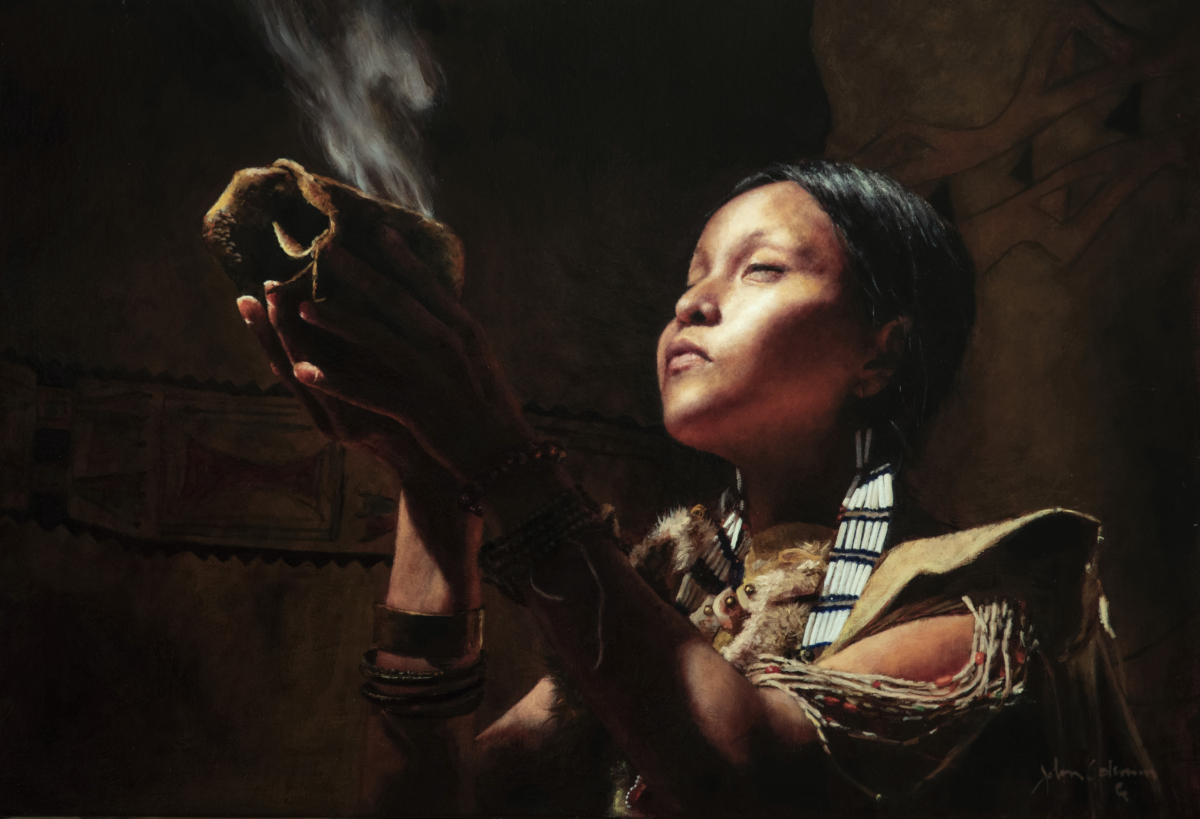
Morning Blessings
John Coleman
oil on canvas
18 x 26 inches (L x W)
Residing currently in Prescott, Arizona, John Coleman started his professional artistic career at 44 years old. Today, Coleman is known for his narrative sculptures and his paintings, all of which emphasize technical accuracy and the conveyance of emotion. As a child, his mother’s support helped foster his interest in art, and Coleman remembers fondly family trips to Laguna Beach where he “first fell in love with the smell of oil paint” while walking through art stores. To inspire his artwork, Coleman looks to Western artistic icons such as Frederic Remington and Charles M. Russell. In addition, viewing Western films “flooded his imagination with subject matter,” which has led to an interest in depicting Native Americans in his work. Regardless of subject, Coleman feels compelled to communicate to others his passion for representing figures and narratives of the American West.
Coleman describes the subject of the painting: “At daybreak, a young woman uses the smoke of smoldering sweet grass to carry her Morning Blessings to the Great Spirit.”
colemanstudios.com
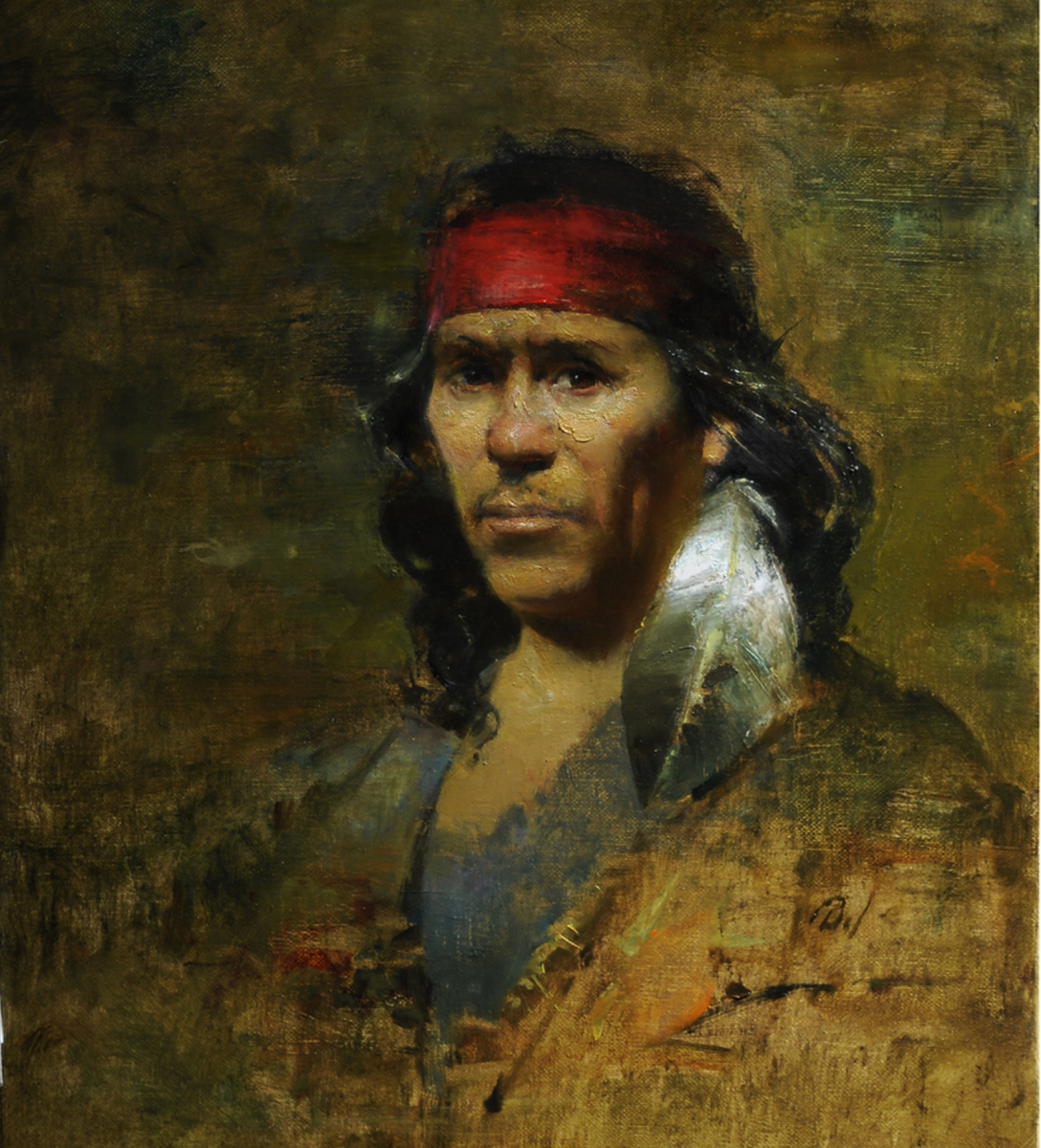
Native Warrior with Eagle Feather
David Leffel
oil
19 x 16 inches (L x W)
As a young boy, a bone disease left David Leffel in various hospitals for eleven years of his childhood. During these hospital stints, Leffel, who showed interest in drawing when he was three years old, was able to foster and hone his drawing abilities. Now known for his representational paintings and “abstract realism,” Leffel seeks to understand beauty and translate its essence through his compositions. While his subject matter includes portraits, landscapes, and figure studies, Leffel asserts that, in actuality, his real subject is the light drifting over the surfaces contained in his work. Rather than painting fruit or people, Leffel, who seeks to comprehend the painting process as a theoretical physicist seeks to comprehend the universe, states that he paints particles and waves, electrons and quarks. In 1992, Leffel moved to Taos with his partner and fellow painter, Sherrie McGraw. Currently, they live in El Prado, New Mexico.
davidleffel.com
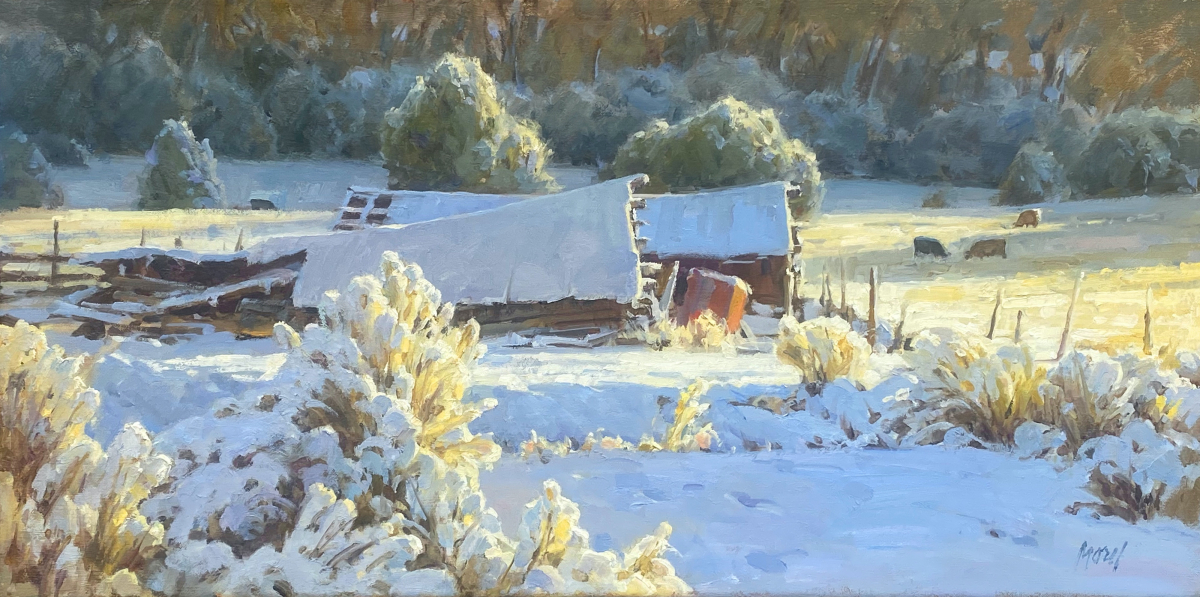
October Snow on the High Road
Chris Morel
oil on linen
12 x 24 inches (L x W)
Born in rural Maryland to parents who encouraged his artistic interests, J. Chris Morel found artistic inspiration initially in the rustic structures and rolling farmland at the foothills of the Appalachian Mountains. After studying graphic design in college and moving to Austin, Texas, Morel chose to pursue painting full time and began with watercolor. However, in 1994, Morel moved to Taos and started focusing on painting outside with oil paints in the high desert region. The vast Taos landscapes, rich light, and strong artistic tradition of the Taos Society of Artists provided the best environment for Morel’s continued artistic development. “I was really learning to see color, light, atmosphere, and the four seasons directly from life,” he says. The drama of the West continuously inspires Morel, who often paints its mountain valleys, adobe structures, and plant life. “The West just takes my breath away.”
Morel notes that this painting depicts “early October snow on my favorite barns up here on the ‘High Road to Taos.’”
morelart.com
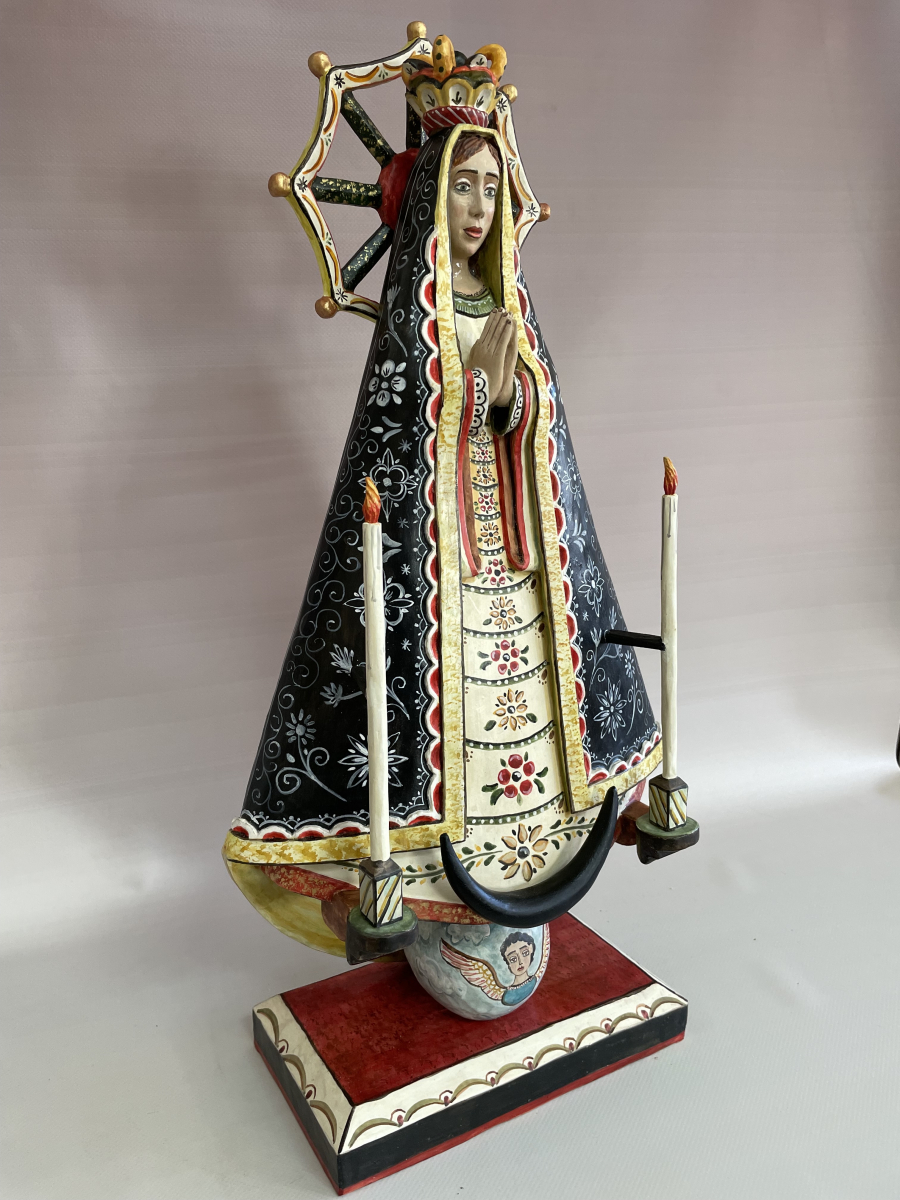
Our Lady of San Juan de los Lagos
Gustavo Victor Goler
painted carved wood
25 x 12 x 6.5 inches (L x W x D)
Born in Buenos Aires, Argentina, but raised in Santa Fe in a family of Latin American art conservators and restorers, Victor Goler did not dream of becoming a professional santero. “I didn’t necessarily go out and pursue it per se. It just sort of happened,” he says. The choice of career path is no surprise when one learns that Goler apprenticed in his family’s conservation studios and carved original santos in high school as a hobby. Since 1986, Goler, who currently lives in Talpa, has worked full time creating retablos, bultos, and lithographs. At the beginning of his career, Goler was a traditionalist who carved mainly popular saints; now his work embraces both old and new forms. Often, he borrows from contemporary imagery after researching a saint’s history and iconography. “I like to do in-depth research on a saint and pull out something you don’t normally see,” he says. While Goler’s santos might have a joke or two inherent in their forms, he asserts, “I like to add a little bit of humor to my pieces, but it’s never sacrilegious. I would never do something to insult the Church.”
victorgoler.com
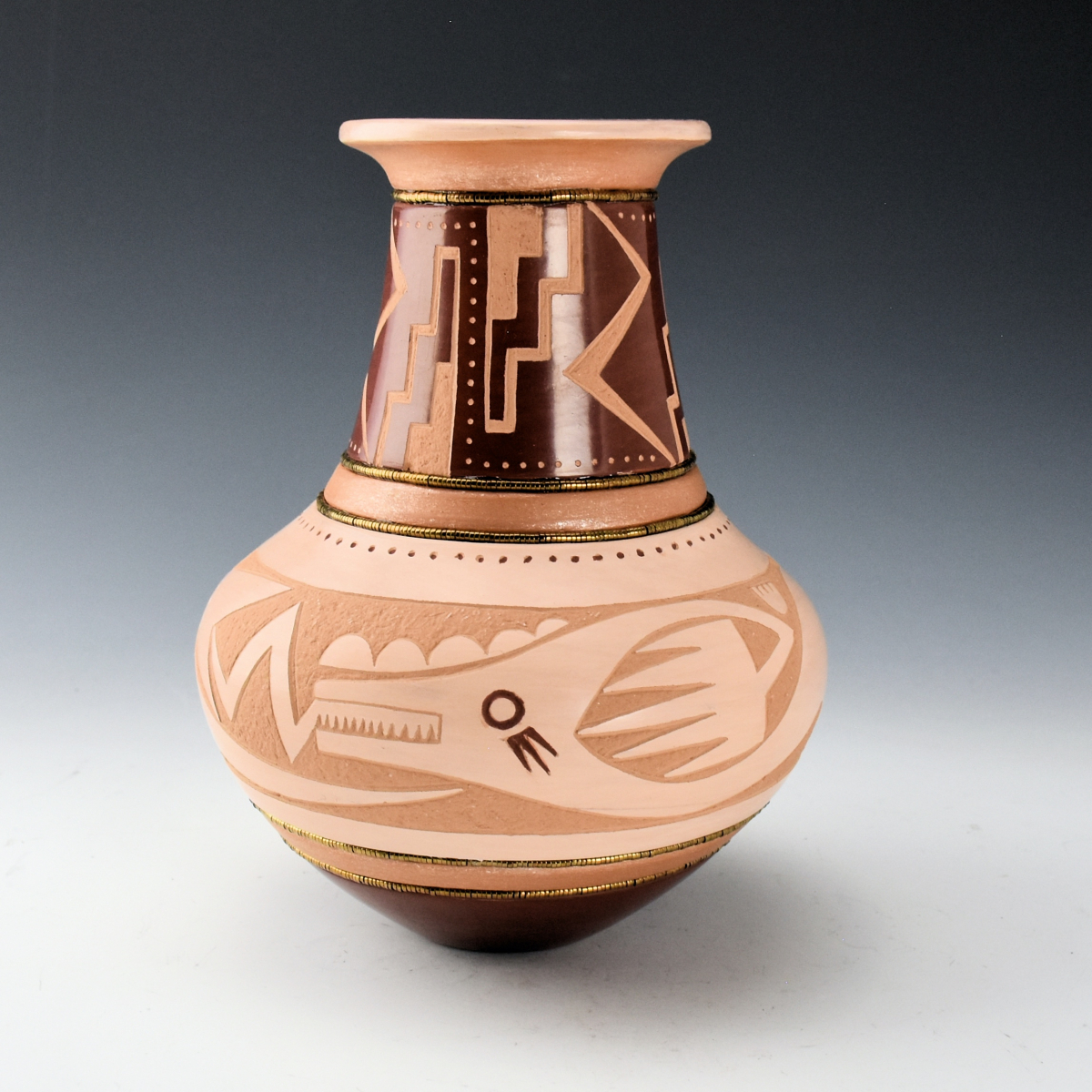
Polychrome water jar
Russell Sanchez
pottery
5.5 x 7.5 inches (L x W)
Born at San Ildefonso Pueblo, Russell Sanchez started to create pottery at a young age after learning techniques from his great aunt, Rose Gonzales (Ohkay Owingeh), a renown ceramicist. While Sanchez’s style is completely his own, and his work displays fine precision and attention to detail, his practice was also influenced strongly by expert potters Dora Tse Pe (Zia) and Popovi and Tony Da (San Ildefonso). Early in his artistic career, Sanchez frequently created small bowls in the famed black-on-black San Ildefonso style. Now, his pottery displays modern innovations on traditional forms, even though he uses the same forming and firing techniques that he was taught as a child. As Sanchez notes, “Everything I do is traditional tools and techniques, but then I think outside of the box.”
Sanchez notes that the piece is San Ildefonso pottery of native clay and traditionally fired.
Courtesy King Galleries, Santa Fe/Scottsdale
kinggalleries.com/brand/sanchez-russell
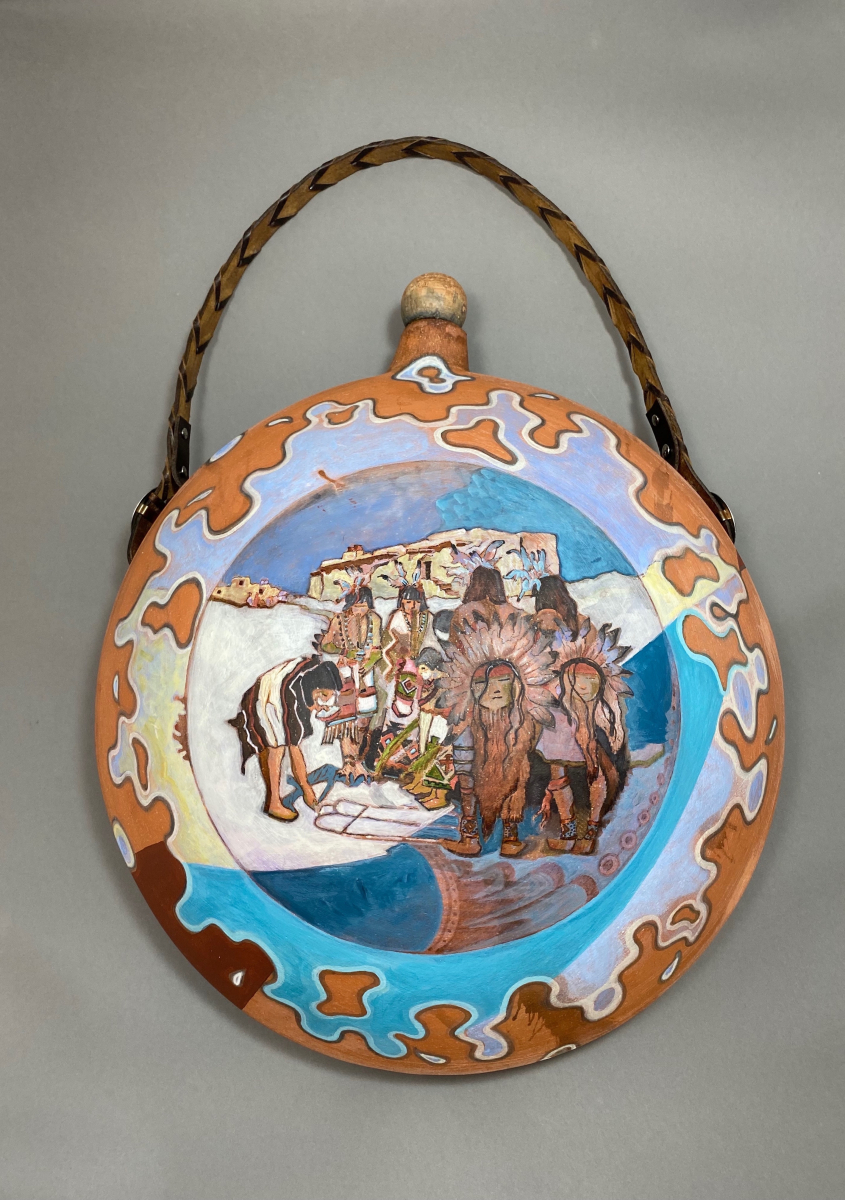
Rain Makers (Inspired by E.I. Couse’s “Hopi Flute Dance” 1922)
Susan Folwell
clay with acrylic, leather, watercolor
18 x 15 x 5 inches (L x W x D)
From Santa Clara Pueblo, Susan Folwell descends from a long line of revolutionary Native American artists. While some of Folwell’s earliest memories are of working in clay with her mother, Jody Folwell, and grandmother, Rose Naranjo, she initially resisted working with ceramics. “For a long time, I wondered why someone would want to do chores for a living,” she says. However, this mindset changed in high school, and Folwell is now well known for her ceramic works that address contemporary issues by bridging humor, history, and popular culture. Throughout her practice, Folwell emphasizes the importance of tradition, which she asserts, “is living history, and I am a part of that.” In addition to creating works that draw from both American popular culture and Santa Clara tradition, Folwell has studied the Taos Society of Artists for a number of years and created a series of work that pairs with and responds to paintings by E. I. Couse, Victor Higgins, and other TSA members.
kinggalleries.com/brand/folwell-susan-b-1970

Riverbends—Fall #8 (early morning)
Jivan Lee
oil on panel
30 x 30 inches (L x W)
Inspired by the artists and landscapes of the Southwest, Jivan Lee is an oil painter who explores the nature of paint as a raw material and catalyst for emotional response in his work. Now based in Taos, Lee grew up in Woodstock, New York, and studied both environmental policy and painting. As result of his earlier studies, in his artistic practice Lee addresses frequently the complexities of how humans see and shape the environment. Emphasizing the importance of direct observation, Lee creates most of his work outside, on location. Lee is known for the manner in which he puts paint on canvas: he applies thick strokes with silicone spatulas, large brushes, dirt, paper towels, and his bare hands. Up close, the resulting canvases might appear to celebrate “paint for paint’s sake,” though from a distance, the paintings reveal themselves to be studies of landscapes, architecture, light, and figures. When asked about his paint application, Lee notes that, “Paint interests me first on a visceral level . . . it also becomes a remarkable tool for helping us find this world anew . . . for being a vessel for learning and feeling.”
Regarding this artwork, Lee says, “Plein air to studio, painted along the Rio Grande south of Taos. Part of an ongoing long-form project of paintings made on location throughout several seasons, following time and change as seen at one place through a constant composition.”
jivanlee.com
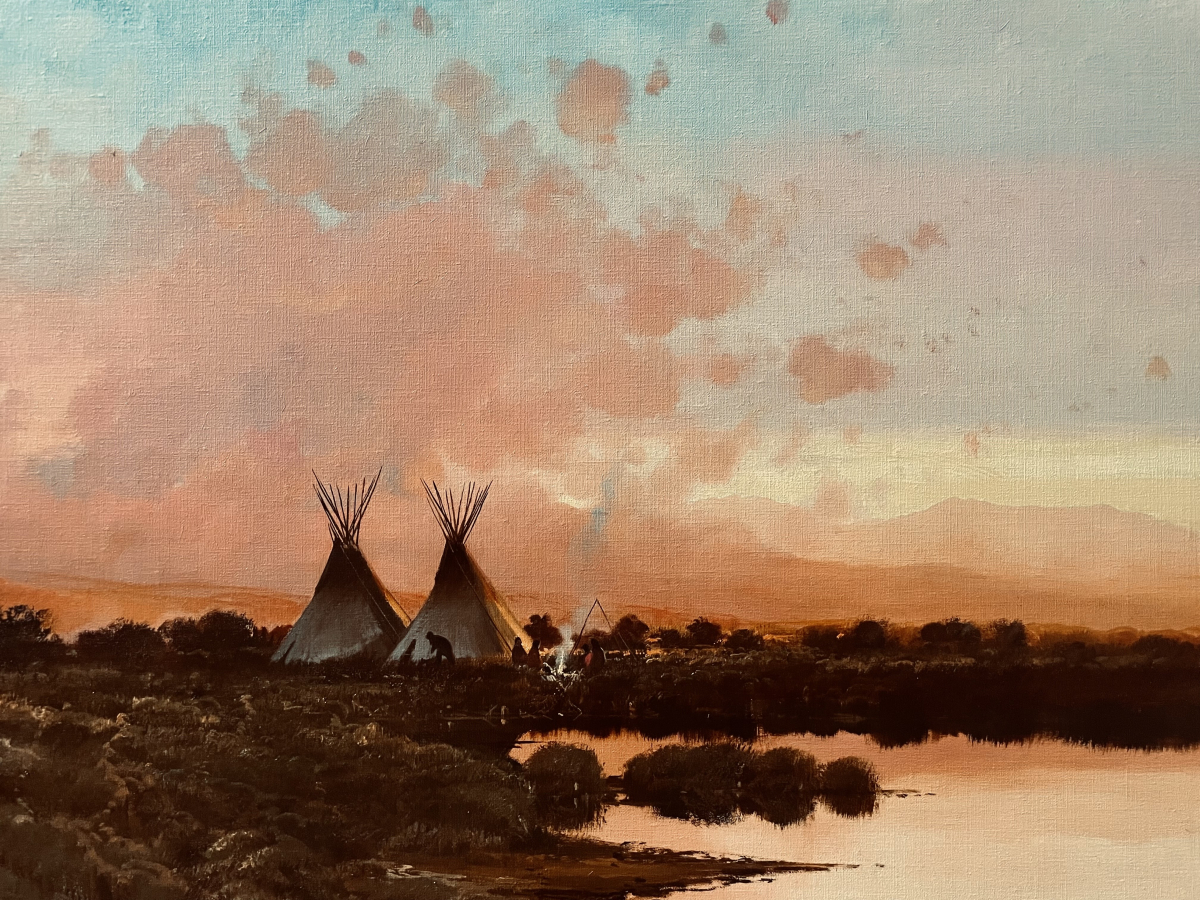
Rocky Mountain Camp
Nicholas Coleman
oil on linen
30 x 40 inches (L x W)
Working out of Provo, Utah, Nicholas Coleman was brought up in an artistic home, and by the time he was 21, he knew that he wanted to be an artist like his father, Michael Coleman. Not your “stereotypical” fine artist, Coleman hunts, fishes, and traps in addition to painting naturalistic landscapes. In his compositions, Coleman focuses on the American West and often paints scenes of wildlife, Native American culture, natural history, and exploration. To Coleman, the goal of his work is to “preserve the heritage of the American West,” which, he notes, has “many untold stories to tell!” Coleman hopes that audience members viewing his work are provoked to explore the natural environment, a desire that comes from his belief that individuals who value Western landscapes will be motivated to protect them. In addition to his father, Coleman has been inspired by the work of artists such as Winslow Homer, John Singer Sargent, and Philip R. Goodwin. Despite these numerous influences, Coleman asserts that, “I’ll paint what I paint. I know who I am. I think that’s a big part of . . . what I’m doing.”
Coleman notes that this painting depicts a view at the base of the Wind River Range in Wyoming.
nicholascolemanart.com
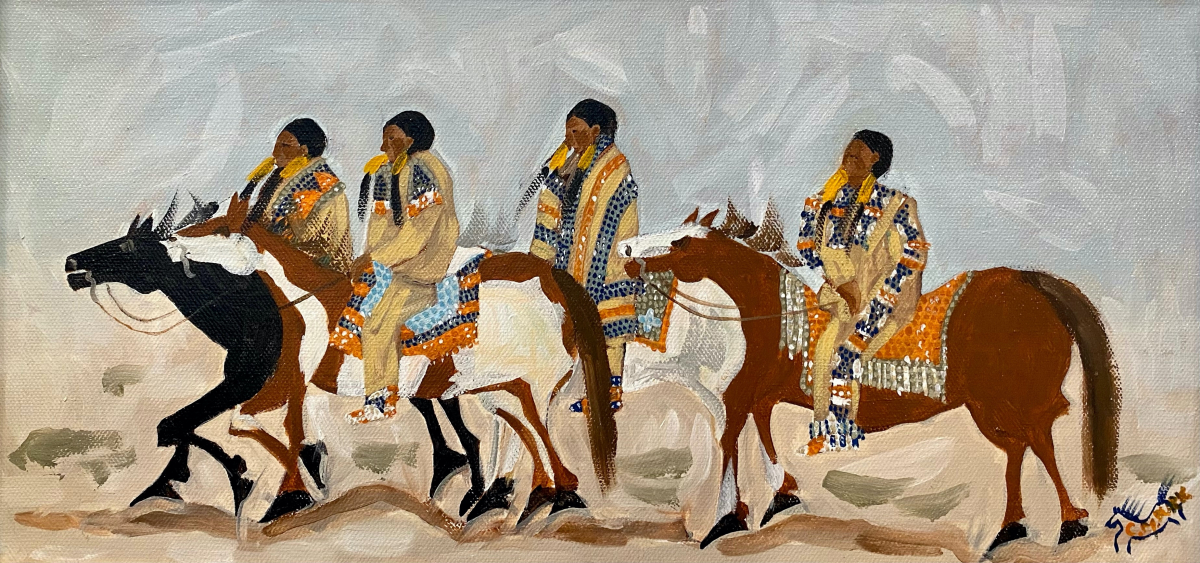
Scouting Around the Plains
Chloé Marie Burk
oil on canvas
8 x 16 inches (L x W)
Born in Poitiers, France, Chloé Marie Burk grew up in the French countryside in a family of artists and artisans. While Burk started creating art at a young age and studied fashion in London and Paris, she had “always known” that something was waiting for her in the United States, and she moved to New York City in 2013. Her work, however, is inspired by the simple way of life and country living of her childhood, hard to find in the bustling city, and she quickly moved westward. Currently, Burk lives in Geyser, Montana, and is interested in preserving the Old West in a modern way through her work. Similar to many others in her field, she has studied and recreated artwork by old Western masters such as W. H. Dunton and Frederic Remington to give her own work, which aims to capture the truth and feeling of the Southwest, a classic feel. Until recently, Burk spent half her time in Taos, a town that she finds “perfect.”
chloemariegaillard.com
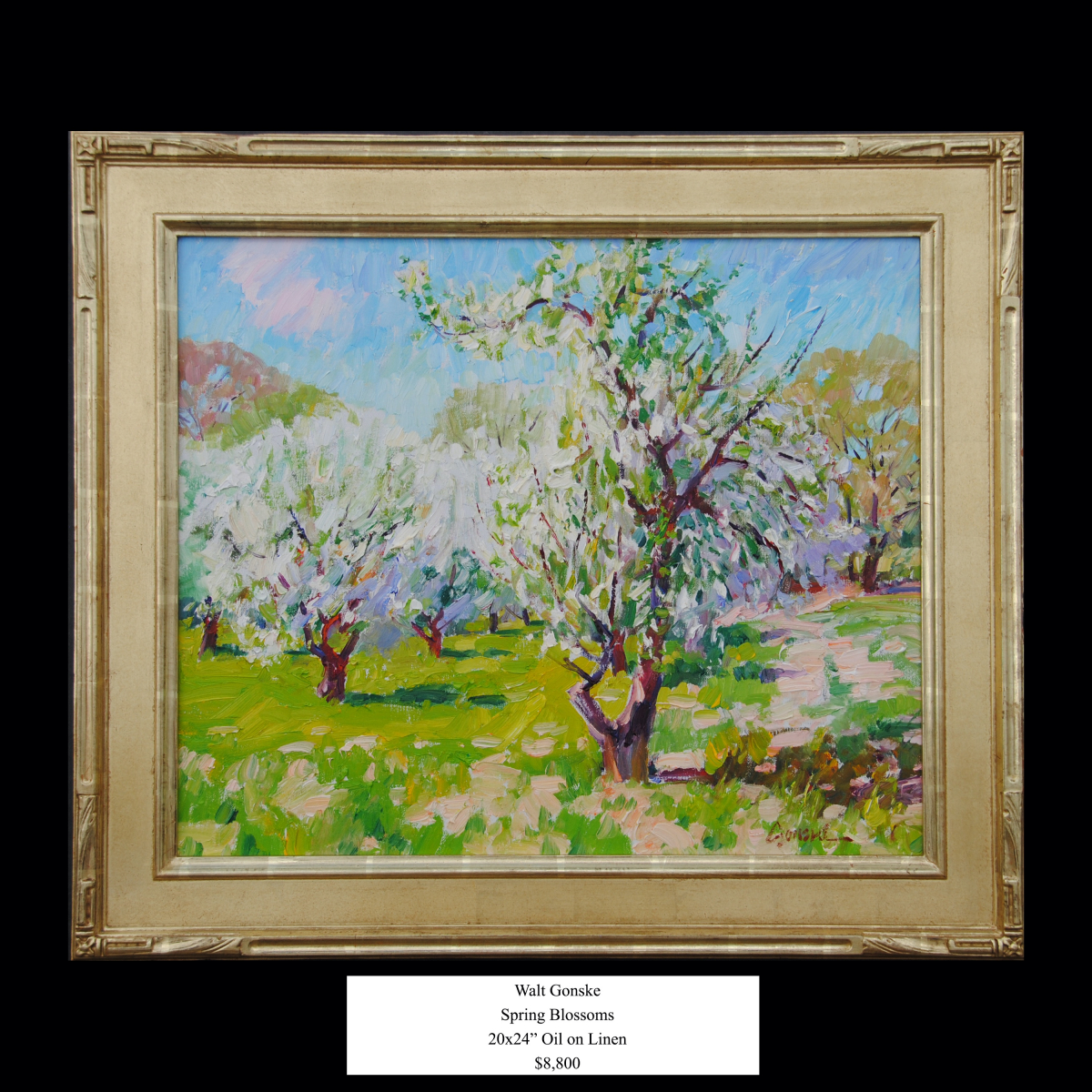
Spring Blossoms
Walt Gonske
oil on linen
20 x 24 inches (L x W)
Following a successful career in illustration in New York, Walt Gonske moved to Taos in 1972 to pursue a career in fine art. At first he worked in watercolor, but the intense light and color of New Mexico inspired him to start painting in oils outdoors. Although he works on location, the paintings that result from his time in nature are not reproductions of what he has observed; rather, they are an interpretation of nature and a direct result of Gonske’s emotional response to his subject. As Gonske notes, “My goal in the work is not to show what I know, but what I feel. The more intensely I can express emotion through paint about the subject, the more likely the viewer will respond.” To circumvent the limitations that inclement weather poses on his plein-air painting, Gonske has customized a Ford pickup truck into his “paintmobile.” With his studio-on-wheels at the ready, Gonske continuously gets closer and closer to achieving his goal of making “a visual record of this beautiful country before it’s gone.”
waltgonske.com
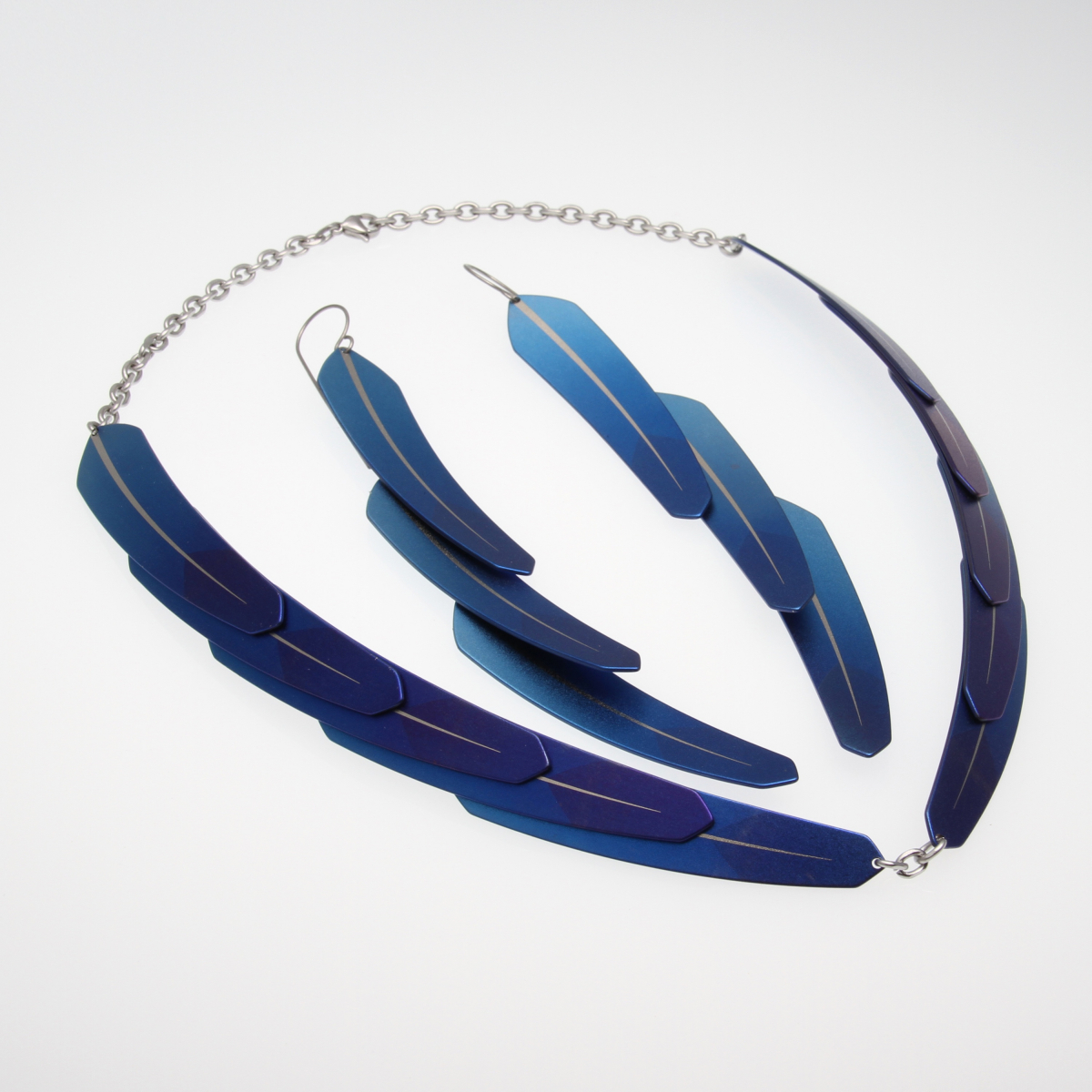
Tangled Up in Blue
Pat Pruitt
necklace and earrings, titanium, edition 1/1
Known for creating cutting-edge metalwork, Pat Pruitt (Laguna Pueblo/Chiricahua Apache) has been making jewelry for over 20 years. Early instruction from Laguna jewelers Greg Lewis and Charlie Bird taught Pruitt the fundamentals of jewelry making and provided him a strong foundation for the art form. In college, however, he studied mechanical engineering and worked as a mechanist. Now, Pruitt’s practice melds both backgrounds to create artwork that explores and challenges the idea of what Native American jewelry is. With innovative materials, designs, and fabrication techniques, Pruitt’s jewelry and metalwork retain industrial feels while acting as homages to, as Pruitt puts it, “where I live, where I come from, what I have learned, what I appreciate.” When asked to explain the driving factor behind his artistic pursuits, Pruitt explains that artists “create out of the passion of our hearts, to be able to do what we do in the matter that we do it. It’s such a blessing.”
pat-pruitt-metalsmith.square.site
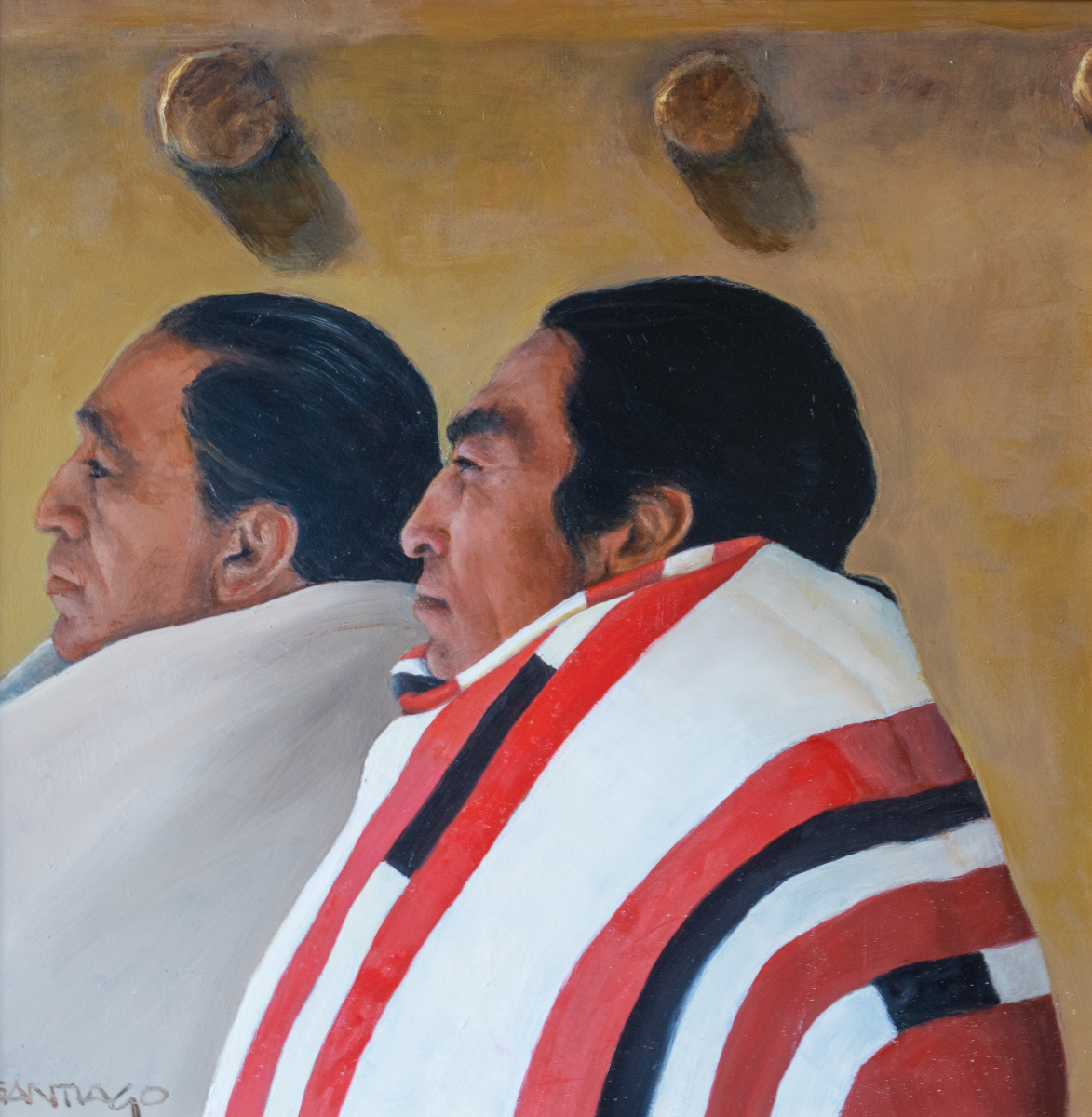
Taos Pueblo Silversmiths
Roseta Santiago
oil on panel
12 x 12 inches (L x W)
Born and raised in the Washington, DC, area, the self-taught Roseta Santiago began her artistic career as a graphics and exhibit designer. Now working and living in Santa Fe, Santiago’s passion is oil painting, and her work is influenced by portrait and still life artists such as Hovsef Pushman, John Singer Sargent, and Emil Carlsen. Asian and Western artifacts have frequently been the focus of her compositions, but now she often portrays the Native peoples of New Mexico. As Santiago explains, “I went from pots to pot makers.” The objects in her still lives, which she was attracted to by their uses, auras, and shapes, often come from her own collection. Initially hesitant to transition into figural work, Santiago says, “I never thought I could paint a person. Now I know I can.” She has long-lasting relationships with her models; the two in this painting are Lyle Wright and George Luhan. Santiago’s respect for and fascination with Native American cultures was one of the motivators for her move to Santa Fe.
rosetasantiago.com
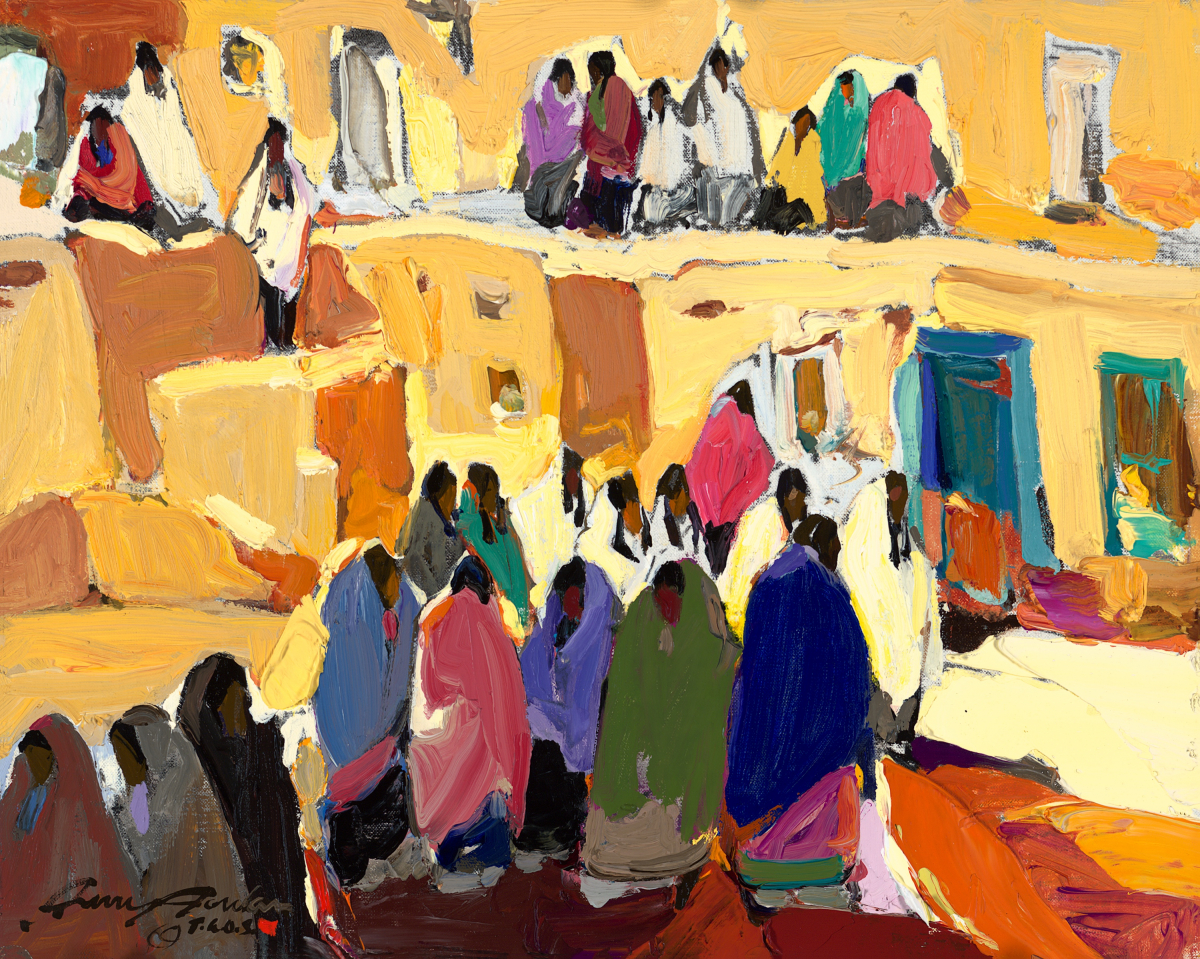
The Binding Force Which Bids Me Stay
Jerry Jordan
oil on canvas
16 x 20 inches (L x W)
Born in Texas, Jerry Jordan expressed an interest in art at a young age and knew by age 16 he wanted to be a painter. At 19, Jordan took a trip to Taos with his family and fell in love with the Taos Society of Artists paintings hanging on the walls of the Kachina Lodge, where he was staying. He notes the importance of his first glimpses of the artists’ work: “My first view of Taos was through those paintings. So when I looked at the landscape, I interpreted it as those early painters had seen it.” Eventually, Jordan, who identifies as a colorist who wants to understand color as more than just a visual experience, moved to Taos, where he resides and which has become his constant muse. His oil paintings capture the landscape and Pueblo life of Taos and the feeling of the town itself. Spirituality is also inherent in Jordan’s work, and he signs all of his work with the acronym, “t.a.o.s.,” or “Together Always Our Spirits.” Jordan has no fear he will ever run out of Taos scenes to paint. “I find the subject of the area of Taos one of the inexhaustible resources,” he says. “It never ceases to excite my whole being.”
Courtesy Parsons Fine Art, Taos
jerryjordantaos.com
parsonsart.com
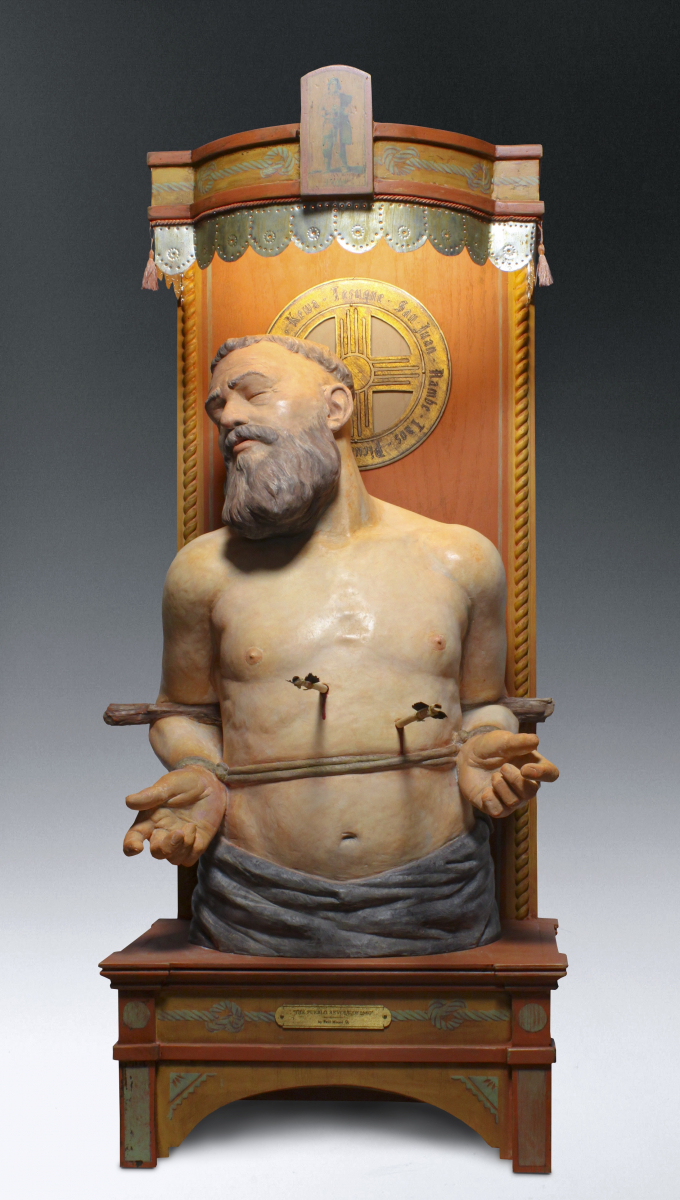
The Pueblo Revolt of 1680
Paul Moore
mixed media (polymer, wood, tin, gold leaf)
49.25 x 22 x 23.5 inches (L x W x D)
A fifth-generation Oklahoman, and former long-time resident of Santa Fe, Paul Moore (Muscogee [Creek] Nation), is a self-taught sculptor who aims to present Western themes in new ways through his work. As a 13-year-old, Moore visited the National Cowboy and Western Heritage Museum in Oklahoma City, where James Earle Fraser’s End of the Trail sparked the longing in him to create his own monumental works someday. While Moore enjoys experimenting with form and drawing subject matter from the West and his Native heritage, he notes that “I’m just a jack-of-all-trades who does it all. But the Western work, I do it for myself. It really gives me that thrill.” In his portraits, Moore focus extends past ensuring the accurate portrayal of physical characteristics, and he aims to express the spirit of the individual that he is depicting. Regardless of subject, Moore notes that his goal is “to do lots of pieces that are totally different. Every year I try to do something that I’ve never seen, to push the envelope.”
Concerning this artwork and its subject matter, Moore says: “The Spanish arrived in what is now known as New Mexico in 1598 and imposed a strict religious, economic and political control over the pueblos. After many years of harsh and brutal rule the pueblo people had finally had enough; led on by a holy man, Popé, they plotted to overthrow the Spanish in 1680. Popé sent knotted ropes to all the Pueblo leaders with instructions to untie one knot each day and the day the last knot was undone they were to attack in unison, killing all the priests and Spanish individuals they could find. The successful revolt drove the Spanish south to the El Paso area for 11 years. Upon their return, they had to change their approach towards the Pueblo people, treating them and their religious beliefs with respect, which helped ensure the survival of their culture. This was the only successful uprising against colonization in North America. The names of the pueblos that took part in the uprising are in the circumference decoration of the Zia halo.”
cowboyartistsofamerica.com/active-members/emeritus/paul-moore
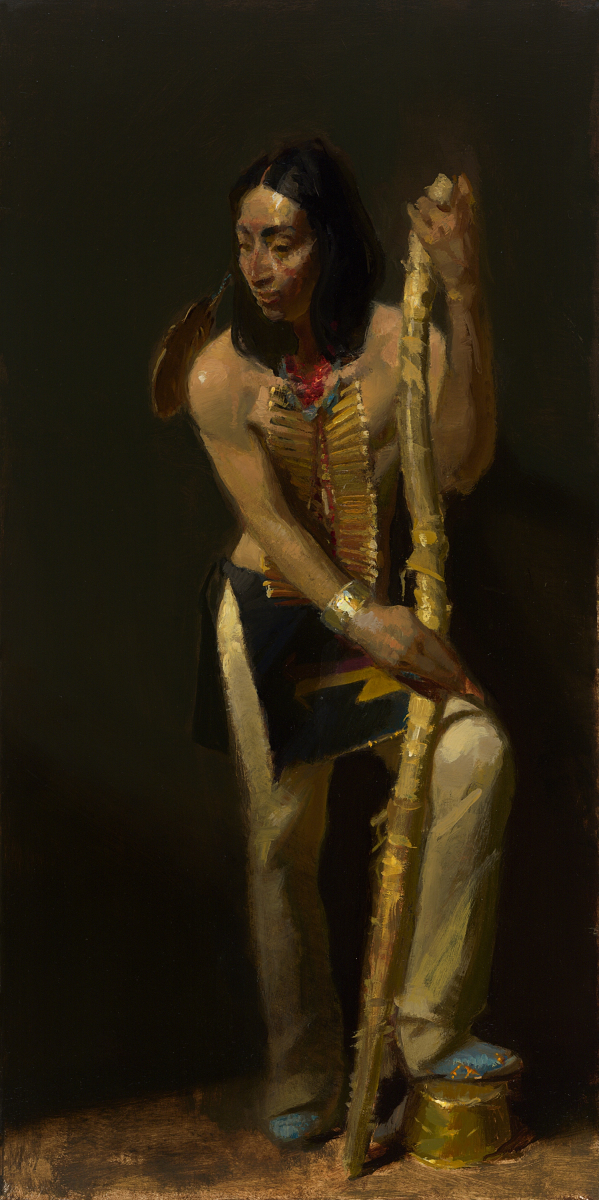
The Walking Stick
Sherrie McGraw
oil on canvas
12 x 24 inches (L x W)
Currently residing in El Prado, New Mexico, Sherrie McGraw knew at four years old that she wanted to be an artist and began copying relentlessly from books on drawing and painting. As a child, McGraw was shy, and she notes that, “Mostly, I watched the world, removed. Without exaggeration, drawing became my lifeline.” That lifeline took her to art classes in Oklahoma City before studying at the Art Students League in New York City, where she met her partner and artistic collaborator, David Leffel. With Leffel, McGraw came up with the term “Abstract Realism,” which she describes as “a vision point of view in which the subject matter is a vehicle—not the reason—for painting the abstract beauty in today’s world.” Following several trips to San Cristobal, New Mexico, McGraw and Leffel bought a house in Taos and moved to the area permanently in 1992. Taos’s beauty has affected McGraw’s work significantly. “My work has progressed and deepened with the solitude of being in the country and having a much more peaceful lifestyle,” she says. “I cannot imagine living anywhere else, nor would I want to.”
McGraw notes that the painting depicts Lyle Wright from Taos Pueblo, “A talented jeweler and exquisite model.”
sherriemcgraw.com
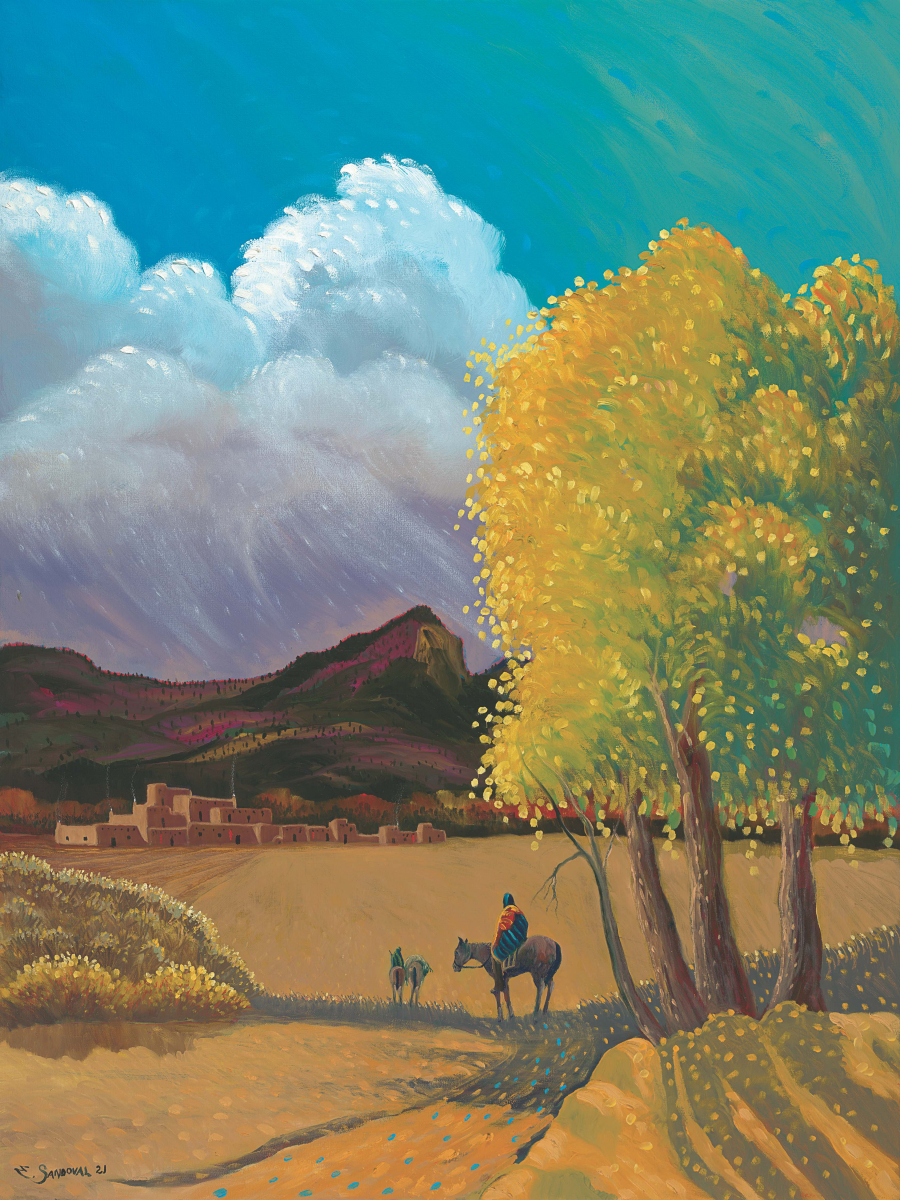
To the Pueblo
Ed Sandoval
oil on canvas
30 x 40 inches (L x W)
As a child, a freak accident left Ed Sandoval in a body cast for a year. To entertain himself during the long days, he turned to art. Today, Sandoval, who was born in Nambe, maintains a connection to this childhood imagination, in part due to his lasting respect for the New Mexico of his boyhood. A painter working in “romantic expressionism,” Sandoval draws, as he puts it, “divine inspiration in creating the old life of New Mexico,” and frequently includes adobe homes, work horses, dirt roads, and pickup trucks in his compositions. In most of his work, Sandoval’s devotion to the “rule of three” is apparent; architecture, people, and the land are wholly united. Sandoval’s signatures, however, are the inclusion of “El Viejito” (the little old man) and the stripe of crimson lining the mountainous horizons in almost all of his images.
Sandoval currently works from a studio on the Couse-Sharp Historic Site campus, and notes that this painting was inspired by Taos Pueblo.
edsandovalgallery.com
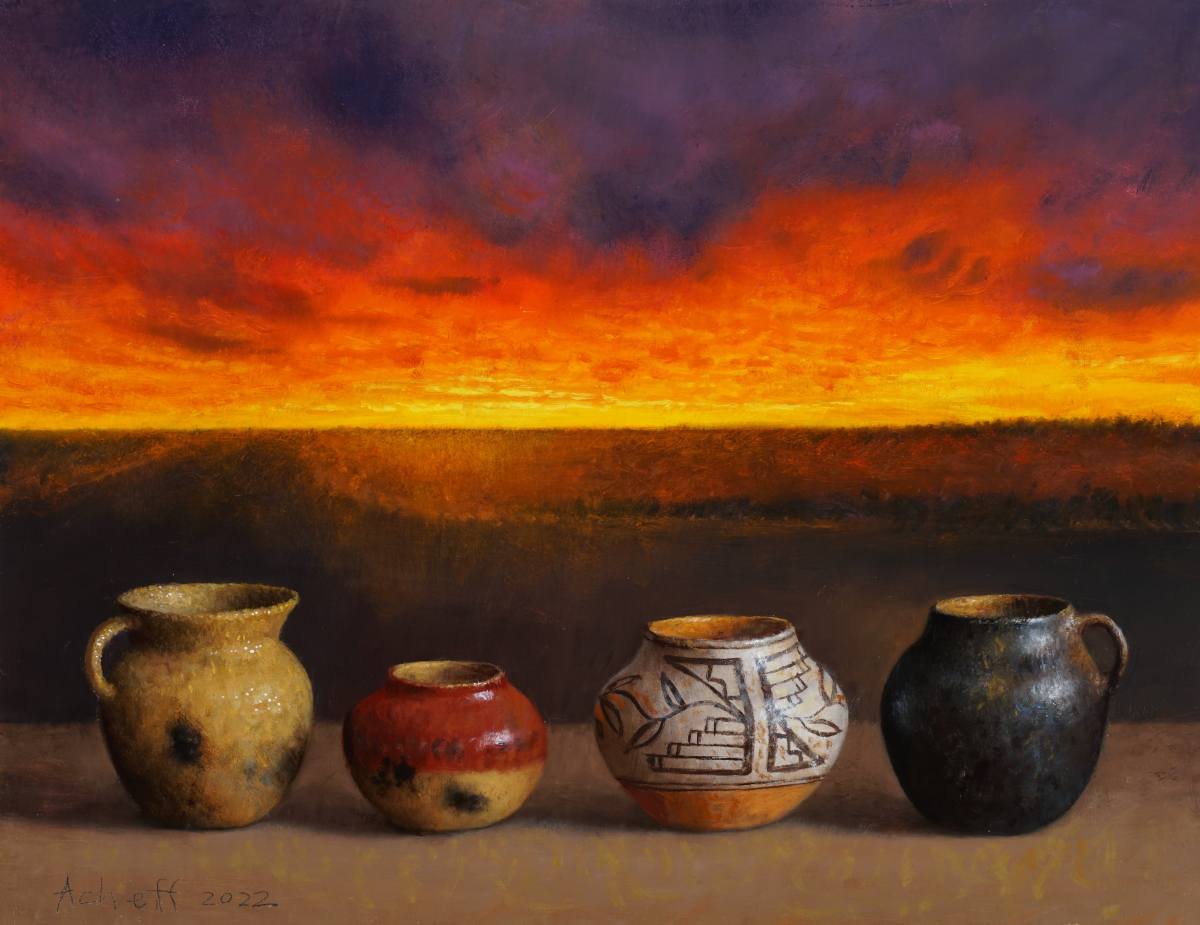
Westward to Taos
Bill Acheff
oil
7 x 9 inches (L x W)
At an early age, Bill Acheff (Alaskan Athabascan heritage) had an intense interest in painting, yet he never dreamed of becoming a professional painter. It took a chance encounter with the Italian artist Roberto Lupetti at a hair salon to reawaken his artistic aspirations. After a European-style apprenticeship with Lupetti, Acheff dedicated himself to painting and honed his trademark trompe l’oeil (“fools the eye”) style of realism. In his compositions, Acheff frequently represents objects and themes indicative of the Southwest. Specifically, his work often contains artifacts from different Native American cultures, for which he has a special affinity. As Acheff explains, “Artifacts and traditions of the past seem to hold more mystical and aesthetic value than those of contemporary times.” In 1973, Acheff moved to Taos, a major turning point in his career, one which allowed him to find his niche and “develop my own style early on.” When asked about motivators for his practice, Acheff states, “I do it for the pure joy of painting . . . and I hope my paintings bring people inner peace.”
acheffstudio.com
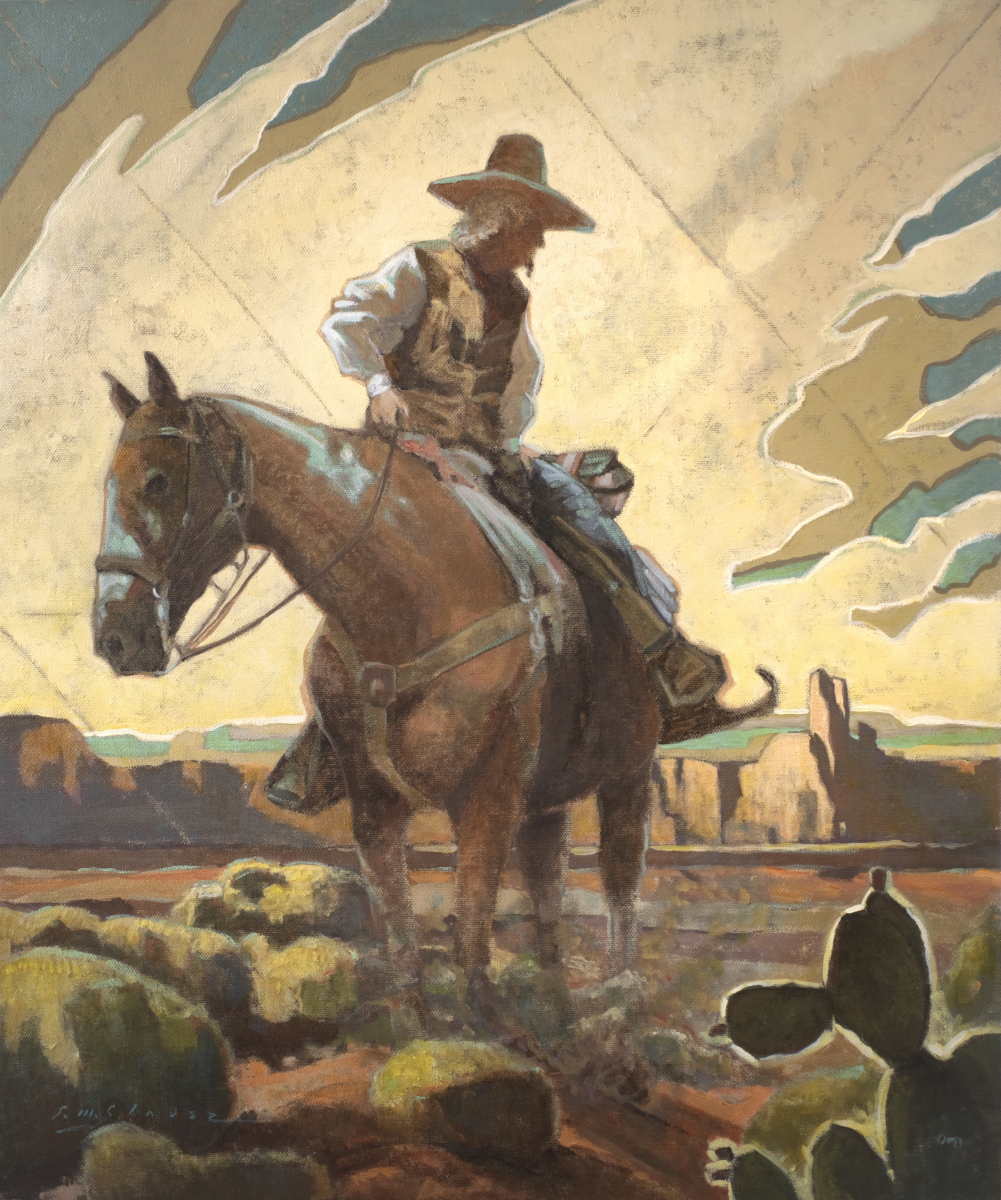
What’s Past is Prologue
S. M. Chavez
oil on canvas
24 x 20 inches (L x W)
Stating that he has “always been artistic,” Sean Michael Chavez has been painting and drawing for as long as he can remember. Rendered in oil paint, Chavez’s compositions present distinctive takes on the land and people of the Southwest through a marriage of old and new. Frequently featuring Native American, cowboy, and Mexican subjects, Chavez’s work reminds viewers of past ways of life and traditions through a decidedly modern style. As Chavez notes, the resulting effect “is my unique vision and experience of being native to the Southwest and more specifically, to the beautiful place known as New Mexico.” Chavez finds a kindship with the land and states that New Mexico “is a place that is part of me more than anything else I can think of. I cannot help but express myself through it. We are one and the same.” Looking forward, Chavez hopes that, one day, his artwork might “inspire the next Dixon, the next Dunton, Couse, or Sharp . . . If that was my role, it would have been well worth living.”
Chavez says, “Everything up until now has merely set the stage for what is yet to come. The painting and its title are not only an allegory for my own journey in art, but on a much wider spectrum, that which has led to this very show at the Couse-Sharp Historic Site in 2022. Without a broken wagon wheel, it is possible none of this would have come to be. As a contemporary, I feel the importance and weight of those that have come before me and it is now my duty and honor to carry that torch with reverence into the zeitgeist.”
paintingsofthewest.com
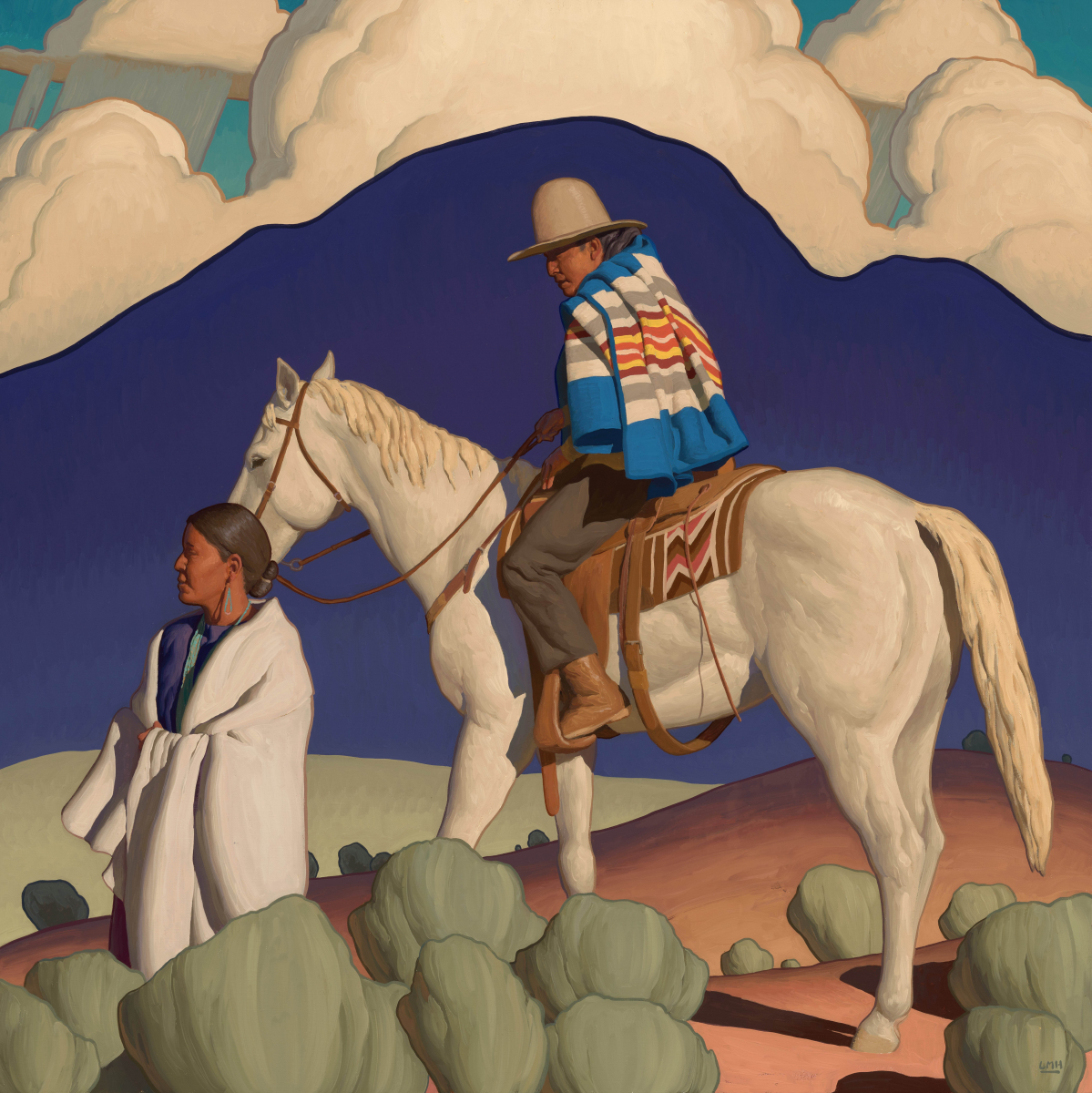
Where the Rain Falls and the Sun Shines
Logan Maxwell Hagege
oil
30 x 30 inches (L x W)
Working out of a studio in Ojai, California, as a young boy Logan Maxwell Hagege showed significant ability and interest in creating art. Visits with his grandmother who lived in the Californian desert provided inspiration for his early practice. Today, Hagege creates modern visions of the American West in a style he has coined “stylized realism.” In his paintings, the sky is prominent, and his signature clouds frequently mimic the forms of the cowboys and Native Americans in the foreground. To gather subject matter and establish deeper relationships with the land and peoples of his paintings, Hagege travels extensively throughout the Southwest and southern California. In addition to finding inspiration in nature and his subjects, Hagege has been guided by the work of painters such as N. C. Wyeth, Maynard Dixon, and Gustav Klimt. While he might be influenced by a particular location, Hagege notes that the scenes that he creates are solely original: “It’s my vision of the world; that’s where it starts and that’s where it ends.”
loganmaxwellhagege.com
